Why is YouTube Broadcasting
Climate Misinformation to Millions?
YouTube is driving its users to climate misinformation and the world’s most trusted brands are paying for it.
January 16th, 2020
“Climate change is one of the most significant global
challenges of our time, and continued greenhouse gas
emissions pose an existential threat to humanity.”
“There is no evidence that CO2 emissions are
the dominant factor [in climate change].”
Richard Lindzen in Climate Change: What Do Scientists Say? -A video being
promoted by YouTube’s algorithm with 1.9 million views
promoted by YouTube’s algorithm with 1.9 million views
Contents
- Annex 1: Methodology for Part I
- Annex 2: Methodology for Part II
- Annex 3: Table - Climate Misinformation Videos Analyzed for Part II
- Annex 4: Full List of Brands Found by Avaaz on Climate Misinformation Videos
- Annex 5: Further Examples of Advertisements Running on Climate Misinformation Videos
- Glossary
- Acknowledgment: The Necessity of Having a Fact-Based Discussion on Climate Change while also Defending Freedom of Expression

Executive Summary
Climate misinformation threatens the health and
safety of our societies and our planet. Protecting
designed to confuse and poison the debate
about climate change must be a key priority
for governments, advertisers and social media
platforms.
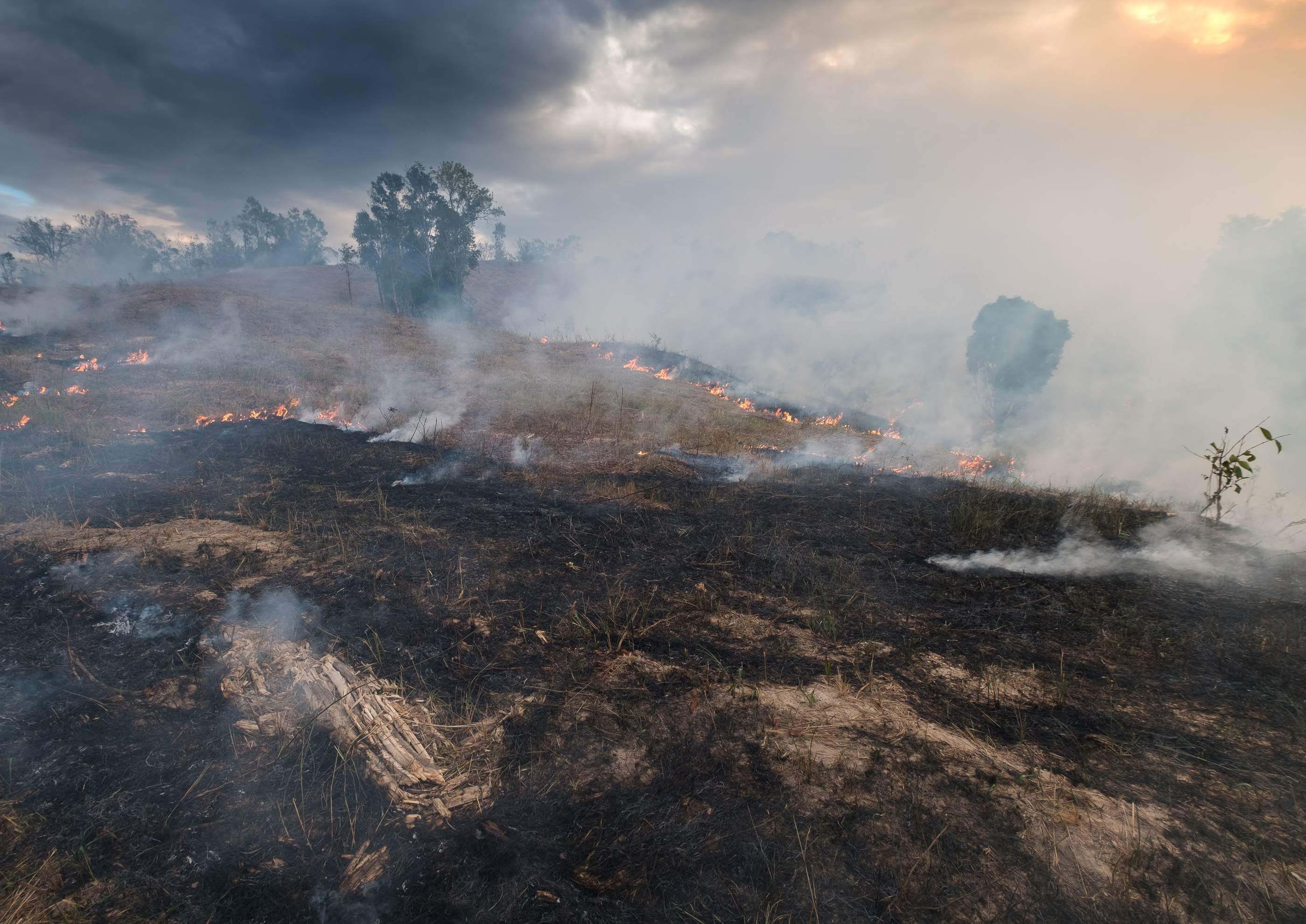
YouTube’s tremendous reach - and control over the content on its site - is unprecedented in media history. People around the globe spend2 a billion hours on YouTube every day, and the platform has two billion monthly active users, 3 which is more than all the households with TVs4 in the entire world. Even more significant when it comes to audience influence, YouTube is able to reach more 18-34 year olds than any cable network in the United States. 5Today, YouTube is the preferred platform for teenagers, according to a recent study6 conducted by the Pew Research Center in the US, with 85% of teenagers (ages 13–17) saying they use the platform.
In 2015, YouTube launched a campaign7 to “help change the way people discuss climate change, so that the issue and its consequences could become more relevant and tangible to people around the world.” In addition, in Google’s February 2019 Whitepaper on fighting disinformation, YouTube’s parent company made it clear that: “We set out to prevent our systems from serving up content that could misinform users in a harmful way, particularly in domains that rely on veracity, such as science, medicine, news, or historical events. To that end, we introduced a higher bar for videos that are promoted through the YouTube homepage or that are surfaced to users through the “watch next” recommendations. Just because content is available on the site, it does not mean that it will display as prominently throughout the recommendation engine."8
With this report Avaaz set out to analyse how effectively YouTube is protecting its users from climate misinformation, and how well it’s implementing the commitments it made last February specifically around its recommendation engine.
For this investigation, Avaaz examined the videos YouTube recommends to users when they search “global warming,” “climate change,” or “climate manipulation.” Specifically, we focused on the videos YouTube suggests to users in its ‘Up Next’ feature, below the video on the mobile app, and as the next video in autoplay. These YouTube promoted videos drive the vast majority9 of what users watch on the site.
We found that YouTube is driving millions of people to watch climate misinformation videos every day. These climate misinformation videos aren’t just being uploaded to YouTube and organically seen by interested audiences. Instead, YouTube’s recommendation algorithm is giving these videos free promotion and showing misinformation to millions who wouldn’t have been exposed to it otherwise.
Secondly, Avaaz found that YouTube is incentivizing this climate misinformation content via its monetization program. Every time an ad is shown on a YouTube video, the advertiser pays a fee,10 of which 55% goes to the video creator and the other 45% to YouTube.
Avaaz found that some of the largest household brands in the world, including Samsung, L’Oréal, Warner Bros, Carrefour, and Danone as well as two of the largest environmental groups in the world, Greenpeace International and World Wildlife Fund, have advertisements running on these climate misinformation videos.
9“YouTube's product chief
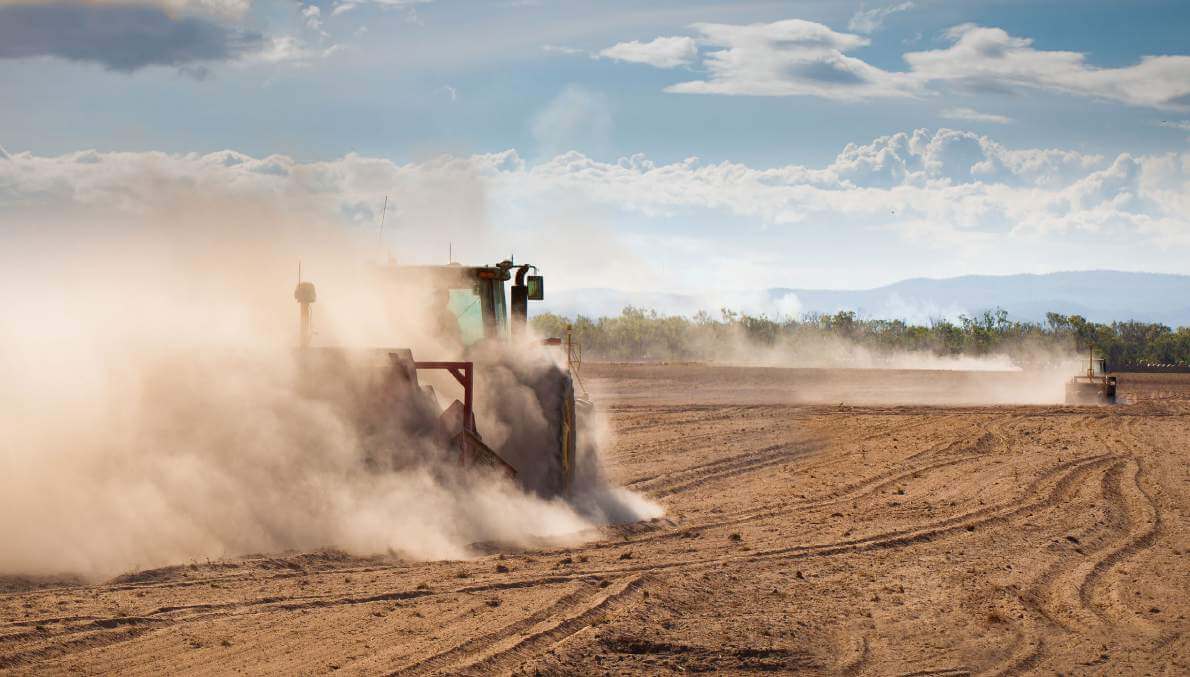
Key Findings of the Report11
- YouTube is actively promoting climate misinformation to millions of users:
- For the search term “global warming, ”16% of the top 100 related videos included under the up-next feature12 had disinformation about climate change.
- For the related videos recommendedto users who searched “climate change” this number equals 8% and rises to 21% for the search term “climate manipulation.”
- The climate misinformation videos Avaaz reviewed had 21.1 million views collectively.
- This is just the tip of the iceberg: Assuming a similar ratio for the thousands of other videos recommended through these and similar search terms, the total views on climate misinformation on YouTube likely add up to hundreds of millions.
- Ads for some of the world’s most trusted brands were found on climate misinformation videos:
- Avaaz was able to identify 108 brands running ads on these climate misinformation videos, including household names like Samsung, L’Oréal, Decathlon, Danone, Warner Bros and Carrefour.
- One in five ads found were from green or ethical brands including Greenpeace International, WWF and Save the Children.
- Greenpeace International, WWF, L’Oreal, Samsung, Danone, Decathlon, Carrefour, Ecosia, Nikin and Save the Children have confirmed that they were unaware that their ads were accompanying these videos and funding their creators.
The videos found and analysed in this report cover a broad range of misinformation themes, from videos titled “ACTUAL SCIENTIST: Climate Change is a Hoax” and “CIA Whistleblower Speaks Out About Climate Engineering Vaccination Dangers and 911” 13 to claims that there is no evidence that CO2 emissions are the dominant factor in climate change.
Avaaz has classified videos as “climate denial and misinformation” if they contained verifiably false or misleading information that has the potential to cause public harm, such as undermining public support for efforts to limit human-induced climate change, as assessed against the scientific consensus represented by the Intergovernmental Panel on Climate Change, NASA, NOAA and other peer-reviewed scientific literature.
In recent years, YouTube has been repeatedly criticized for promoting conspiracy theories and pushing misinformation, and the company has introduced important reforms in response. In January 2019, YouTube pledged14 “to limit recommendations of borderline content and harmful misinformation, such as videos promoting a phony miracle cure for a serious illness, or claiming the earth is flat.” In addition, in some countries, including the US, UK, Spain, Germany, South Korea15 and India16, YouTube is displaying information panels17 when people search for topics that are “prone to misinformation” — these consist of boxes of text that provide topical context from YouTube’s third party partners like Wikipedia.
Sixty-four percent of the climate misinformation videos Avaaz analyzed for this report were found to have an information panel from Wikipedia, containing general information about global warming. However, there was no flag to users that these videos contained misinformation and they were still being suggested by YouTube.
In order to effectively protect societies from this harmful misinformation, YouTube must take a more systemic approach. After consultation with industry experts, advertisers and legislators around the world,
Avaaz recommends that YouTube:
- Detox the YouTube Algorithm -- The company must end its free promotion of misinformation and disinformation videos by extracting such videos from its algorithms, starting immediately by including climate misinformation in its borderline content policy.
- Demonetize Disinformation -- Add disinformation and misinformation to YouTube’s relevant monetization policies, ensuring such content does not include advertising and is not financially incentivized. YouTube should start immediately with the option for advertisers to exclude their ads from videos with climate misinformation.
- Correct the Record -- Work with independent fact-checkers to inform users who have seen or interacted with verifiably false or misleading information, and issue corrections alongside these videos.
Avaaz believes that YouTube has the opportunity to be a trailblazer in the fight against misinformation: the company is already committed to solving this problem and creating a better and safer information environment for its users. Now is the time for YouTube to act more systematically and more urgently to implement solutions, like the recommendations described above, to ensure this new decade is not plagued by the disinformation problems started in the last one.
Similarly, advertisers must both ensure that they follow through on their own corporate social responsibility commitments and track what kind of content their advertising revenue is inadvertently funding - and work with YouTube to be more transparent and socially responsible when it comes to where the platform places their brand names. Advertisers must establish detailed ethical ad placement requirements for platforms that include correcting the record and detoxing the algorithm. Avaaz commends the brands who have already begun this critical work.
I. How YouTube
Promotes Climate
Misinformation
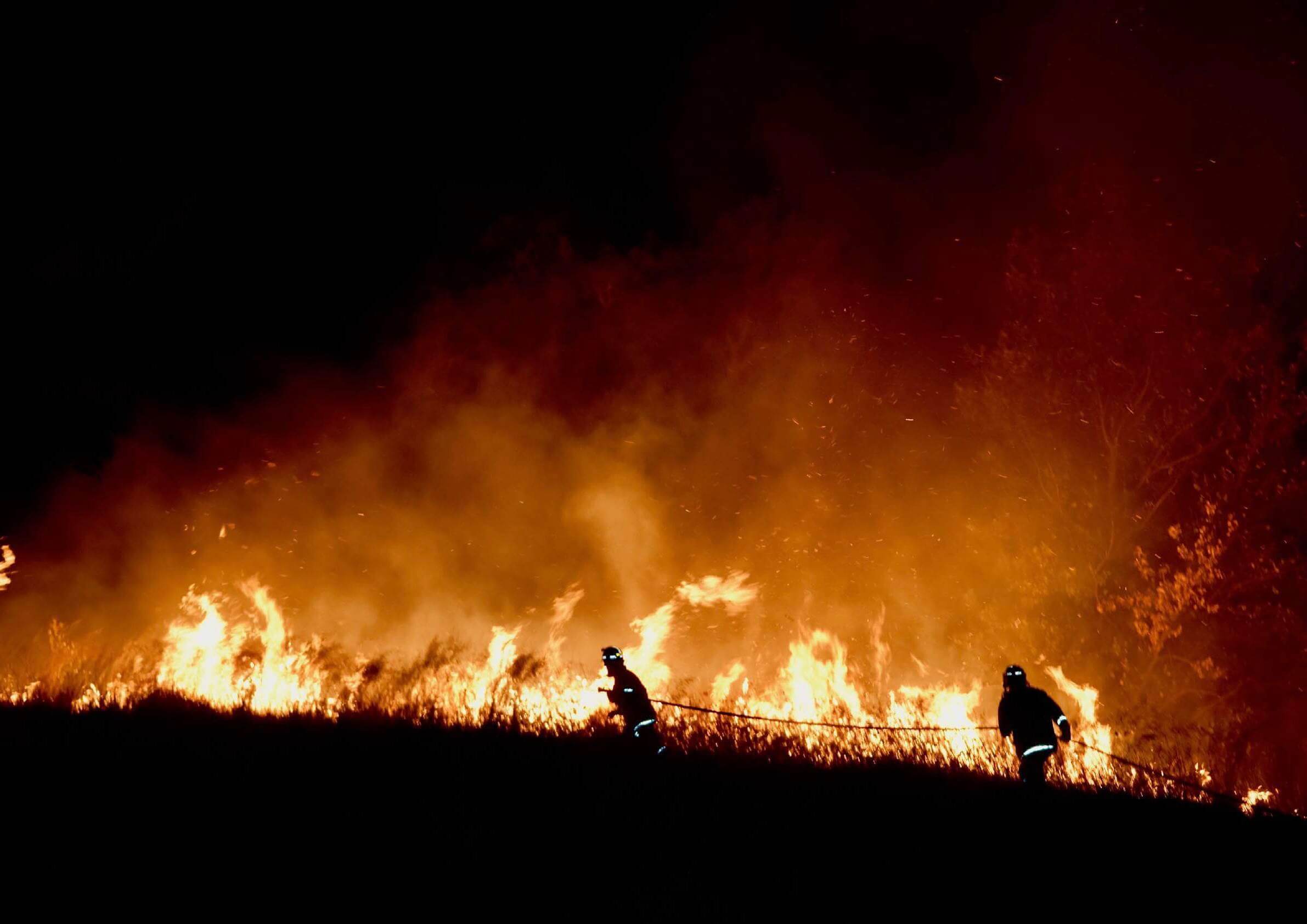
The instrumental role of the algorithm
Recommended videos are a key part of the YouTube user experience: According to18 the platform’s chief product officer, Neal Mohan, 70% of the time users spend on YouTube is driven by the platform’s recommendations. In order to keep viewers on the site longer, the YouTube algorithm makes personalized19 recommendations to the user either in the form of videos on the platform’s landing page, as the “up next” video played after the video, or in the sidebar. These recommendations are meant to help viewers find content they might want to watch among millions of videos available on the site. However, there have been harmful unintended consequences to this model. For instance, for every climate misinformation video someone watches or likes, similar content is likely to show up in that person’s recommendations, thereby trapping the viewer in an online bubble of misinformation.20
For our investigation, Avaaz conducted a series of YouTube searches in English on three climate topics, collected the top results and queried YouTube APIs asking for the top related videos from these search results. In the end, we gathered a total of 5,537 videos. Avaaz focused on the following three search terms: “global warming,” “climate change” and “climate manipulation.” We chose the two neutral search terms (“global warming” and “climate change”) to analyse what type of videos would be recommended to an average YouTube user interested in the issue as well as “climate manipulation” as a more charged search term, which refers to the conspiracy theory that powerful corporations and governments are controlling the climate.Our full methodology is explained in the Annex.
The results of our investigation are clear: YouTube is promoting misinformation about climate change to millions. Sixteen percent of the top 100 videos detected by the YouTube API to be highly related to the initial video results for the search term “global warming” had misinformation about climate change. These related videos play a significant role in what winds up being recommended by YouTube in its “Up Next” feature and suggestions bar. For related videos based on the search term “climate change” this number equals 8% and rises to 21% for the search term “climate manipulation”. In total, the climate misinformation videos Avaaz found for this investigation had 21.1 million views.
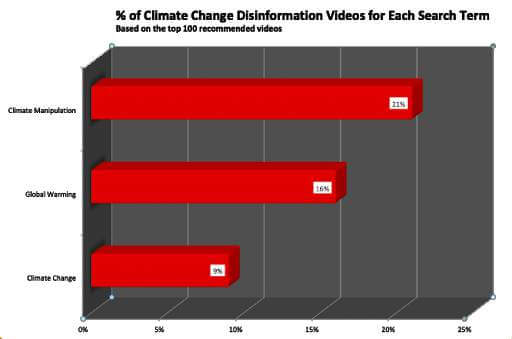
By focusing its recommendation algorithm on views and time spent on videos, YouTube has opened the door to promoting content whether it is misinformation or not as long as people keep watching. Our research also shows that this may have had an impact on virality and engagement: Over 20% of the views for the top 100 related videos for the search term “global warming” were on climate misinformation videos. For videos recommended based on the search term “climate change” this number equals 17% and rises to 27% for the search term “climate manipulation.”
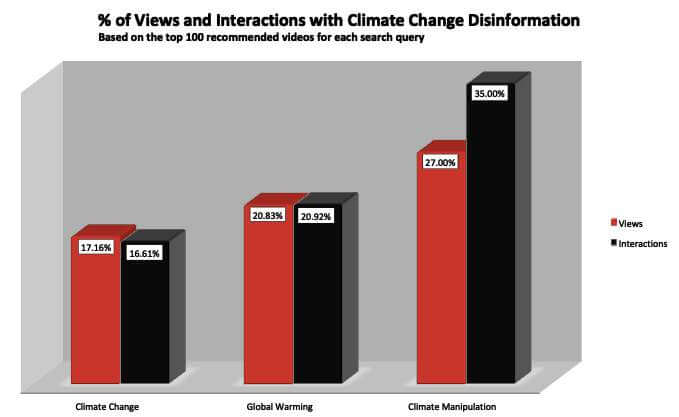
Disinformation videos account for over 20% of views for YouTube videos related to global warming
Each circle is a video whose size is equal to number of views, and only videos with more than 500,000 views labeled.
Based on the top 100 related videos for global warming related search queries.
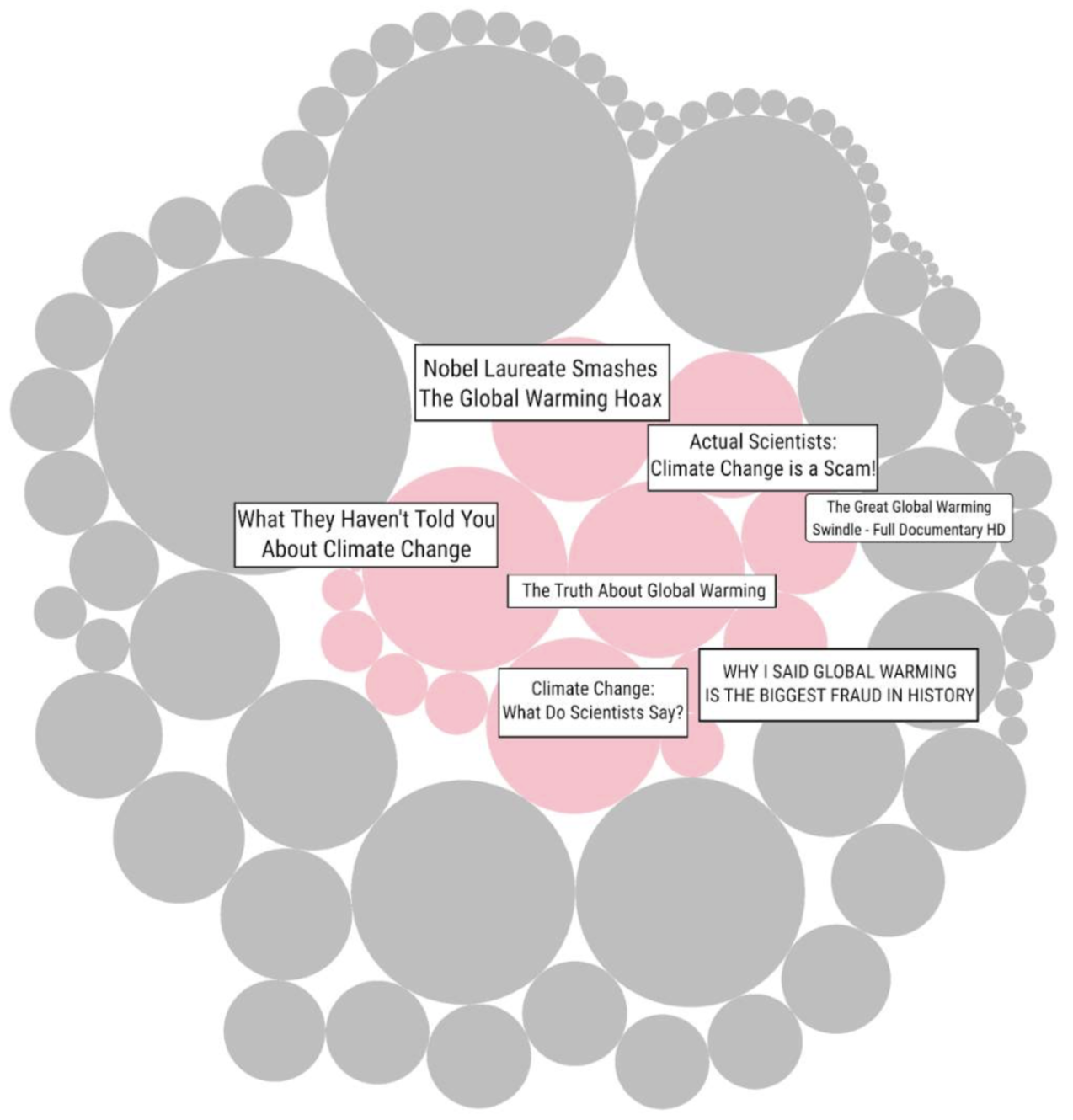

II. Climate Misinformation
Videos on YouTube
& the Global Brands
Advertising on Them

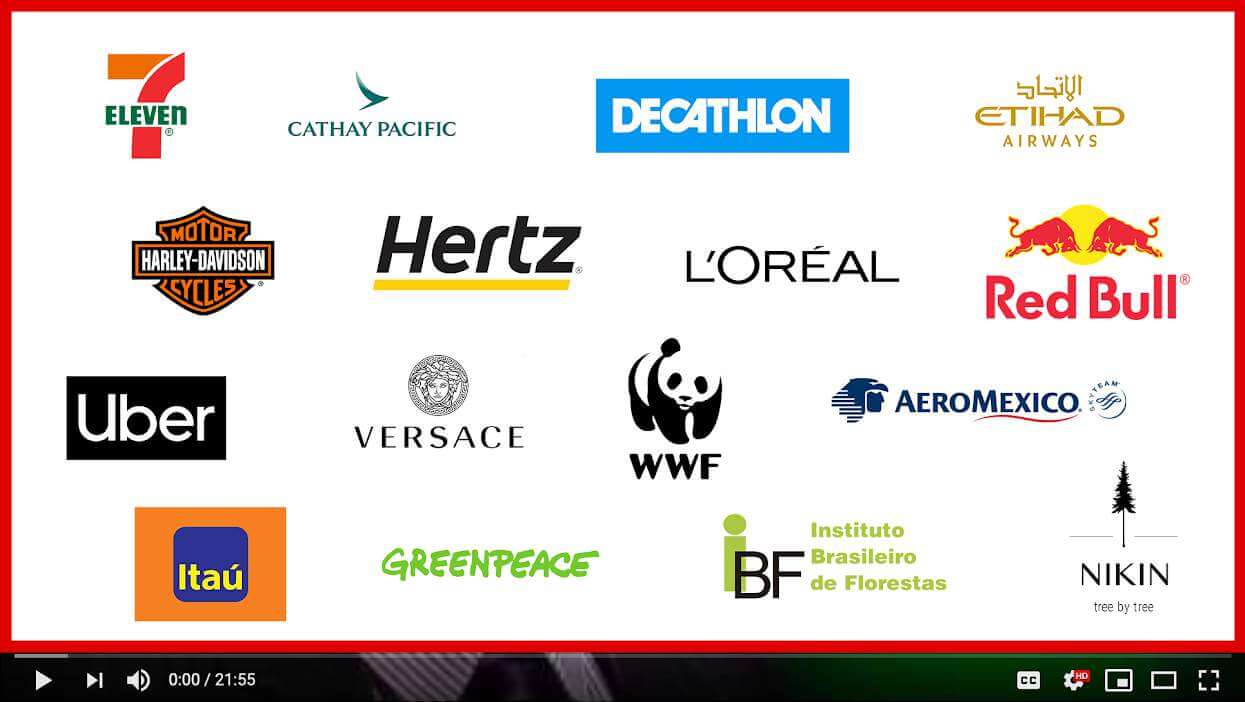
Avaaz found ads from a significant number of the world’s most widely recognized and trusted household brands and environmental companies and NGOs running on the climate misinformation videos we analysed for this report.
For Avaaz’s investigation into which brands had ads on climate misinformation videos, our research team focused in on the top 10 most viewed misinformation videos for the “global warming” search term, and the top 5 most viewed misinformation videos for the “climate change” and “climate manipulation” search terms respectively. Our intent was not to do a comprehensive examination but to get an overview of which ads tended to appear on the most trending videos recommended by YouTube.21
In total, Avaaz was able to identify 108 brands running ads on these climate misinformation videos. One in five of the ads shown were from green or ethical brands as well as public entities, such as Greenpeace International, WWF, Ecosia, Save the Children, the German Interior Ministry, and Eureciclo. Avaaz also found that 12.5% of the ads on the monetized videos were from household brands. In just two days of research and 10 viewings per video in six countries, some brands such as Aeromexico, Uber, Samsung, Decathlon, L’Oreal and Harley Davidson appeared over five times, sometimes over 10 times. For a full list of the brands and advertisements found by Avaaz during this investigation, see Annex 4.
It is crucial to understand that these ads are actually helping to financially incentivize the creation of climate misinformation content. Every time an ad is shown on a YouTube video, the advertiser pays a fee22, of which 55% goes to the video creator and the other 45% to YouTube.
Avaaz reached out to several of the companies and NGOs whose advertisements were found on climate misinformation videos. As of publication of this report, Greenpeace International, WWF, L’Oreal, Samsung, Danone, Decathlon, Carrefour, Nikin, Ecosia and Save the Children have confirmed that they were unaware that their ads were accompanying these climate misinformation videos.
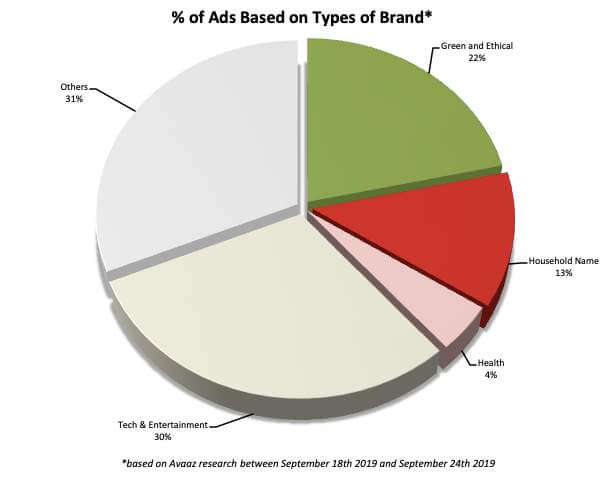
How Ad placement on YouTube Works
Several audience and content targeting methods23 for video ads are available to advertisers on YouTube, such as targeting based on demographic groups, interests, placements on YouTube channels or videos, topics, keywords, etc. One option for advertisers is automatic placement24 of their ads. Alternatively, advertisers can choose to have managed placement25 for ads, which is a targeting method advertisers can use to specifically choose websites, videos and apps that are part of the Google Display Network. Unlike the automatic placements, advertisers select managed placement themselves. YouTube provides content exclusion settings26 that let advertisers opt out of showing their ads alongside certain categories of websites, videos and mobile apps that may not be appropriate for their brand or serve their advertising goals. Such categories include sensitive social issues, tragedy and conflict, sexually suggestive content, and sensational and shocking content. All content creators who are part of YouTube’s monetization program -- meaning they have ads running on their videos that they earn money for -- must comply with advertiser-friendly content27 guidelines, otherwise advertising will be disabled on their videos. In reviewing YouTube’s relevant monetization policies, however, Avaaz was not able to find any direct mention of misinformation as a criteria for content where advertising is banned or disabled.

Below are a few examples of the monetized climate misinformation videos found by Avaaz as well as the advertisements that accompany them. Avaaz researchers reviewed some of the main claims made by each of these videos. Our team was easily able to find evidence confirming that these claims were verifiably false or misleading (ie misinformation) as assessed against the scientific consensus represented by the Intergovernmental Panel on Climate Change, NASA, NOAA and other peer-reviewed scientific literature.
Note: In some countries, YouTube promotes a Wikipedia article on global warming under some of the videos we found in this investigation, which is part of YouTube’s current effort to fight climate misinformation.28 However, YouTube does not give users an indication that the video itself contains misinformation. And, as this research shows, these videos are still promoted by YouTube’s algorithm.
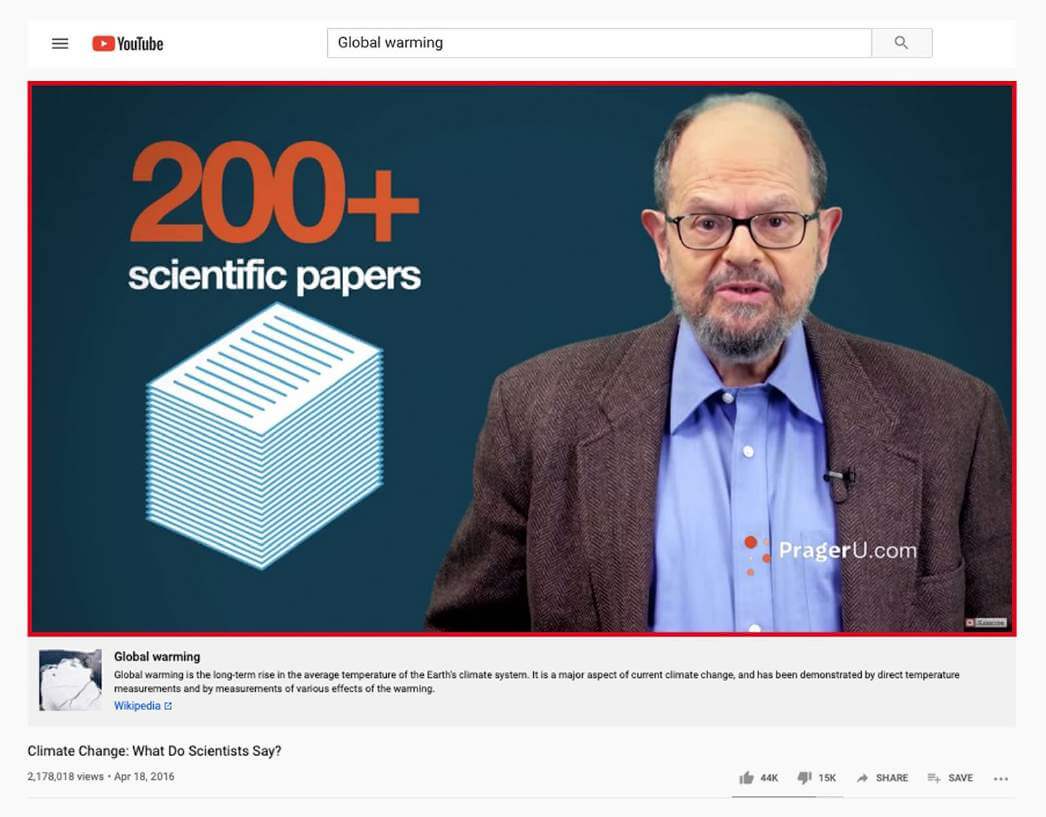
VIDEO EXAMPLE #1
What They Haven’t Told You about Climate Change29
This video was uploaded on the PragerU channel, which has 2.31 million subscribers and claims to promote “Judeo-Christian values.” It is curated by the conservative30 talk-radio host Dennis Prager. At the time of Avaaz’s research in August, the video had been viewed over 2.6 million times since it was first published on July 27, 2015. Since August it has already racked up nearly an additional 1 million views.31 There are many claims in Moore’s videos. Here are a few of the main claims found to be verifiably false or misleading by Avaaz:
- There has been no significant warming trend in the 21st century.
- Temperatures and carbon dioxide levels do not show a strong correlation.
- Patrick Moore is a co-founder of Greenpeace.
NASA Earth Observatory32 has confirmed that: “The world is getting warmer. Whether the cause is human activity or natural variability—and the preponderance of evidence says it’s humans— thermometer readings all around the world have risen steadily since the beginning of the Industrial Revolution...According to an ongoing temperature analysis conducted by scientists at NASA’s Goddard Institute for Space Studies (GISS), the average global temperature on Earth has increased by about 0.8° Celsius (1.4° Fahrenheit) since 1880. Two-thirds of the warming has occurred since 1975, at a rate of roughly 0.15-0.20°C per decade... The line plot below shows yearly temperature anomalies from 1880 to 2014 as recorded by NASA, NOAA, the Japan Meteorological Agency, and the Met Office Hadley Centre (United Kingdom). Though there are minor variations from year to year, all four records show peaks and valleys in sync with each other. All show rapid warming in the past few decades, and all show the last decade as the warmest.” 33
31As of December 12, 2019
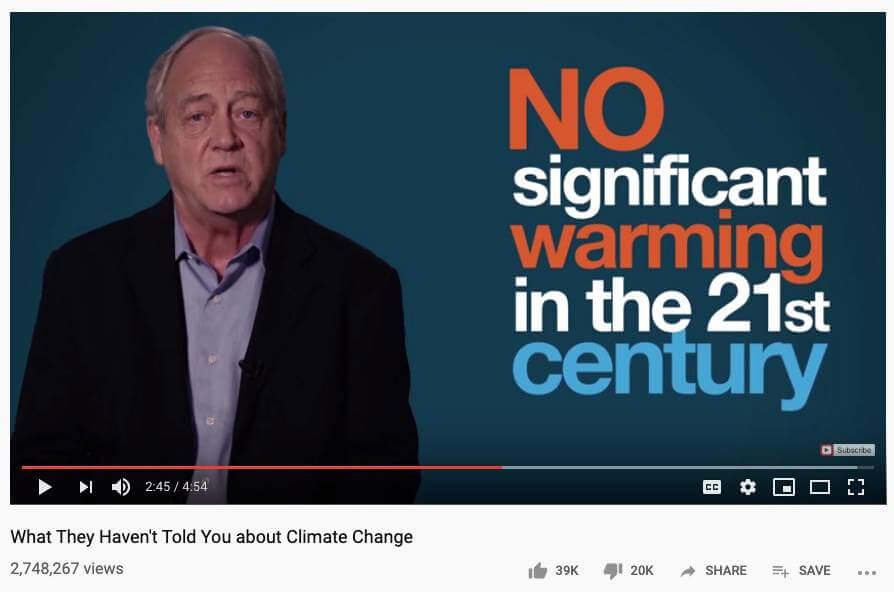
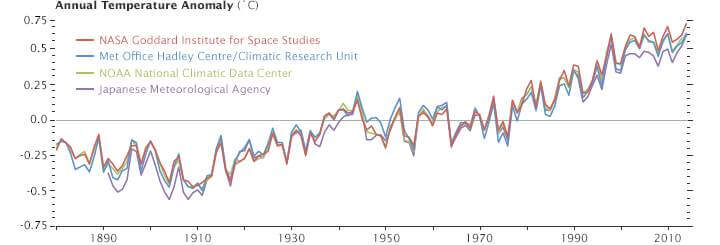
The scientific community agrees that there are many factors that play into climate change, but Moore ignores the mountain of peer reviewed studies showing that changes in CO2 levels is the cause of past cooling and warming periods.
For example, The National Oceanic and Atmospheric Association (NOAA) concludes: "One of the most remarkable aspects of the paleoclimate record is the strong correspondence between temperature and the concentration of carbon dioxide in the atmosphere observed during the glacial cycles of the past several hundred thousand years. When the carbon dioxide concentration goes up, temperature goes up. When the carbon dioxide concentration goes down, temperature goes down." 33, 34
In a caption in this video it says Patrick Moore is a co-founder of Greenpeace; however, Greenpeace has denied this, saying that “although Mr Moore played a significant role in Greenpeace Canada for several years, he did not found Greenpeace.”35 In the past, Moore has been criticized36 for his alleged relations with the nuclear, timber and plastics industries and lobbies.
35 Further sources: Jouzel, J. et al. Orbital and Millennial Antarctic Climate Variability over the Past 800,000 Years. Science 317, 793–797 (2007); Luthi, D. et al. High-resolution carbon dioxide concentration record 650,000–800,000 years before present. Nature 453, 379–382, 10.1038/nature06949 (2008); Luthi, D. et al. EPICA Dome C Ice Core 800KYr Carbon Dioxide Data. IGBP PAGES/World Data Center for Paleoclimatology Data Contribution Series # 2008-055. NOAA/ NCDC Paleoclimatology Program, Boulder CO, USA (2008); Lacis, A. A., Schmidt, G. A., Rind, R. & Ruedy, R. A. Atmospheric CO2: Principal Knob Governing Earth’s Temperature. Science 330, 356–359 (2010); Came, R., Eiler, J., Veizer, J. et al. Coupling of surface temperatures and atmospheric CO2 concentrations during the Palaeozoic era. Nature 449, 198–201 (2007).
36Greenpeace have stated that: "Although Mr Moore played a significant role in Greenpeace Canada for several years, he did not found Greenpeace." Greenpeace has said: "Phil Cotes, Irving Stowe, and Jim Bohlen founded Greenpeace in 1970." Mr Moore left Greenpeace in 1986 see: https://www.bbc.co.uk/news/world-uscanada-47543905
Eleven brands were found with ads on this video. See examples below of Danone, NIKIN and Ecosia’s ads
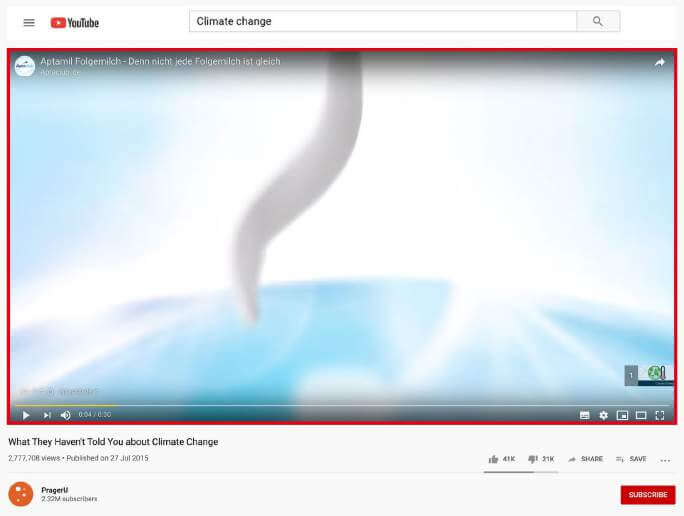
Danone Ad
Danone is a French multinational food-products corporation. This ad presents Danone’s baby milk formula Aptamil. On its website39 Danone states: “Climate change is a profound, systemic challenge—not in the future, but right here, right now,” and that “Danone is meeting this challenge head on by committing to be carbon neutral by 2050 and co-creating carbon positive solutions.” Danone is a member of the Global Alliance for Responsible Media.
NIKIN Ad
NIKIN is a fair and sustainable fashion brand based in Switzerland. They also invest in tree planting programs to counteract global deforestation41. In this advert, NIKIN promotes its clothing line explaining that for each product sold, one dollar is donated to reforestation projects all over the world.
38The screenshot of the ad taken during this research has been altered for the sake of design. Copy of the originals are available upon request.
40The screenshot of the ad taken during this research has been altered for the sake of design. Copy of the originals are available upon request.
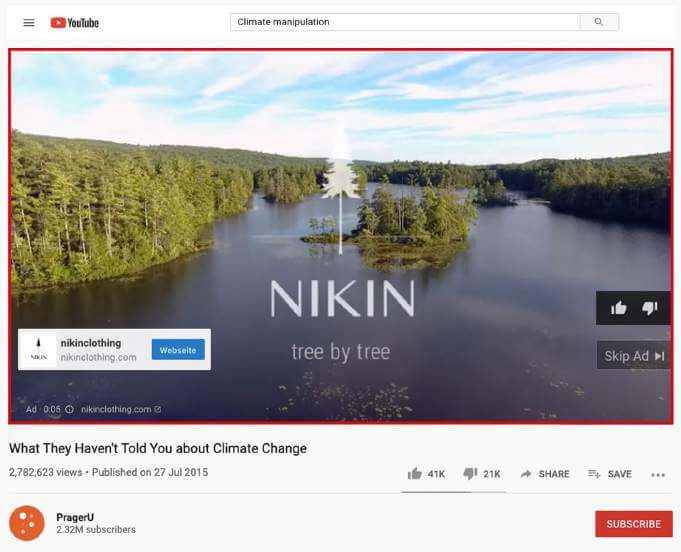
Ecosia Ad
Ecosia is an internet search engine that donates a large part of its profits (80% in August 201943) to reforestation organizations. In this ad, Ecosia is promoting its search engine and explains its policy of reinvesting its profits in planting trees worldwide.
42The screenshot of the ad taken during this research has been altered for the sake of design. Copy of the originals are available upon request.
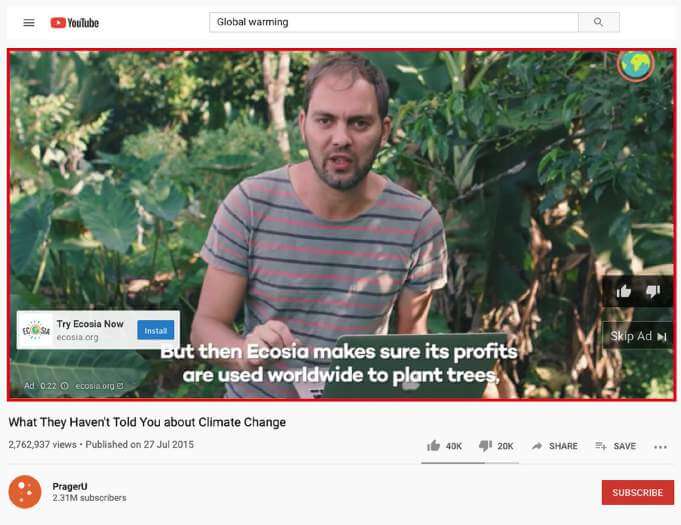
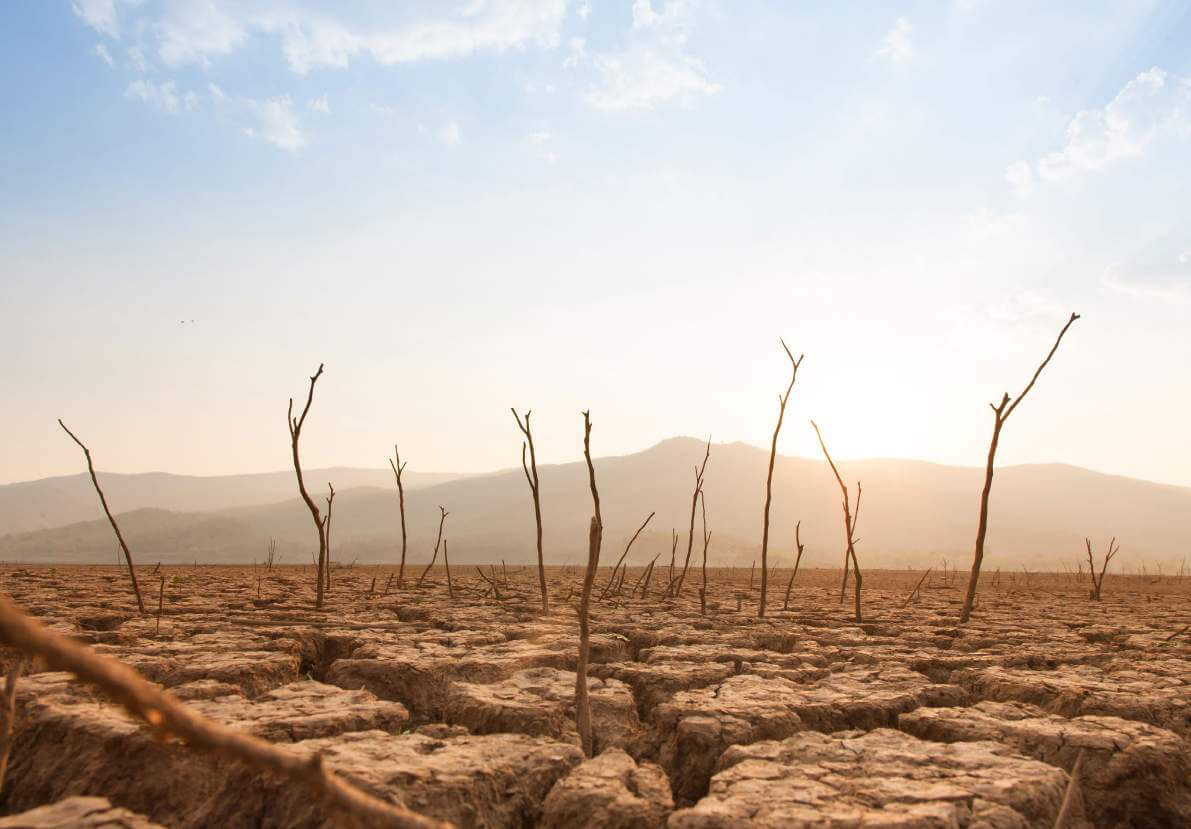
VIDEO EXAMPLE #2
The Truth About Global Warming44
This video, an excerpt of a much longer interview with Dr. Patrick Michaels, was published on the Fox News channel. At the time of Avaaz’s research in August, this video had been viewed over 2 million times since its publication on October 21, 2018. Since then, the video has racked up an additional 460,000 views.45
There are many claims made by this video. Some of the core claims that Avaaz found to be misinformation include:
- 31 of 32 climate models are flawed by design to vastly over-predict warming
- Only half of global warming might be caused by human activity, beginning in 1976
As the video says: “There are 32 families of computer models that are used by the United Nations, each government sponsored. And all of them are predicting far, far too much warming...[the 31 models] are what is called parameterized. They're all parameterized, can I translate parameterized into English? Fudged. They don't get the right answer, don't know the right answer for a certain phenomena, so we essentially put in code steps that give us what we think it should be. And the systematic error that was made was the models were tuned, yes, I said, tuned.”
According to the IPCC: “There is considerable confidence that climate models provide credible quantitative estimates of future climate change, particularly at continental scales and above. This confidence comes from the foundation of the models in accepted physical principles and from their ability to reproduce observed features of current climate and past climate changes. Confidence in model estimates is higher for some climate variables (e.g., temperature) than for others (e.g., precipitation). Over several decades of development, models have consistently provided a robust and unambiguous picture of significant climate warming in response to increasing greenhouse gases.” 46,47
In addition, according to the fact-checking organisation Climate Feedback,48 the claim that only half of global warming might be caused by human activity, beginning in 1976, is incorrect: “Human-caused warming did not begin in 1976, as Michaels claims. No evidence or research is provided to support this claim, which contradicts the published scientific literature. [...] Multiple factors— some human-caused and some natural—combine to influence global temperatures. However, human activities were already causing warming in the first half of the 20th century, and are responsible for approximately 100% of the more-rapid warming taking place after 1950. Thus, humans are responsible for most of the warming since 1900.” 49
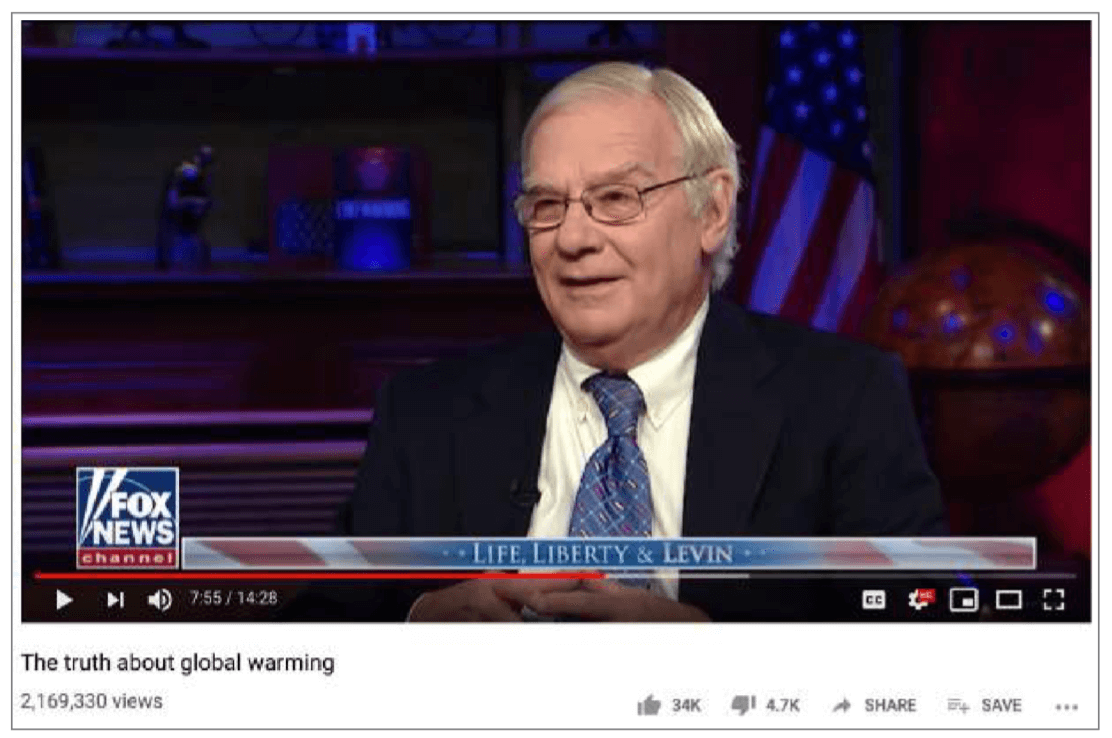
45As of December 12, 2019
47For more information, see FAQ 8.1, extracted from Chapter 8 of "IPCC, 2007: Climate Change 2007: The Physical Science Basis. Contribution of Working Group I to the Fourth Assessment Report of the Intergovernmental Panel on Climate Change. [Solomon, S., D. Qin, M. Manning, Z. Chen, M. Marquis, K.B. Averyt, M.Tignor and H.L. Miller (eds.)]. Cambridge University
Thirty-one brands were found advertising on this video in the timeframe of Avaaz’s research. Below are advertisement examples from L'Oreal, Decathlon, Lionsgate, and Versace.52
L’Oréal Ad
L’Oréal, based in France, is the world's largest cosmetics company. Here, L’Oréal advertises its Pure Charcoal range of skincare products for men. In 2017, L’Oréal launched Women4Climate,54 an initiative aiming to “empower and mentor young women who develop projects addressing climate change in their home city.” In the same year, the US branch of L’Oréal was named the most sustainable company of the year by Newsweek’s Green Ranking.55
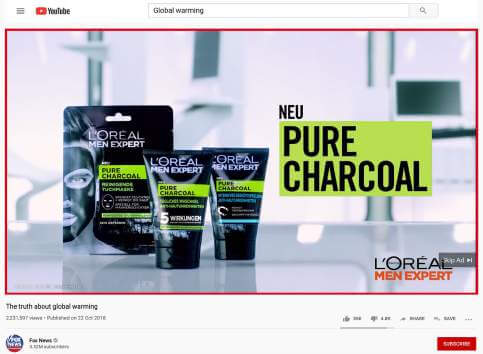
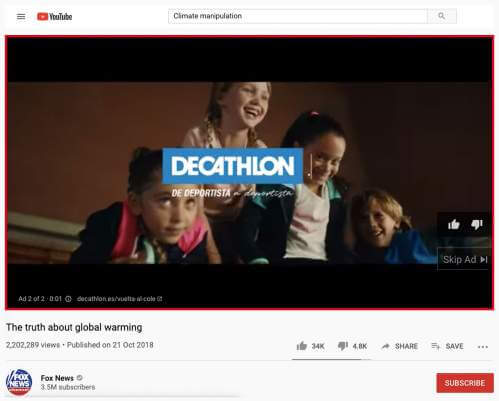
Decathlon Ad
Decathlon is a French multinational retailer distributing sports equipment and clothing. This ad is part of the company’s back-to-school campaign encouraging children to get involved in sports. In the sustainability section of Decathlon’s website the company states: “Decathlon identified reducing greenhouse gas emissions as one of our priority challenges in 2013. In 2017 we increased our oversight of emissions-measuring efforts and in 2018 we expanded these to our product suppliers.”57
48Climate Feedback is accredited by the International Fact-Checking Network at Poynter. “Climate Feedback is a non-partisan, nonprofit organization dedicated to science education. Our reviews are crowdsourced directly from a community of scientists with relevant expertise. We strive to explain whether and why information is or is not consistent with the science and to help readers know which news to trust.” See: https://climatefeedback.org/climate-feedback-accredited-by-theinternational-fact-checking-network-at-poynter-for-the-second-year/
49https://climatefeedback.org/claimreview/on-fox-news-patrick-michaelsfalsely-claims-humans-are-only-responsible-for-half-of-global-warming/. Climate Feedback noted: “This claim is being reviewed months after the interview first ran because it has recently been recirculated by blogs dismissive of climate science, and has been one of the most highly promoted videos by YouTube’s suggestion algorithm in recent weeks.”
52In the timeframe of Avaaz’s research between September 18 and September 24.
53The screenshot of the ad taken during this research has been altered for the sake of design. Copy of the originals are available upon request.
56The screenshot of the ad taken during this research has been altered for the sake of design. Copy of the originals are available upon request.
Lionsgate Ad
Lionsgate Entertainment Corp (Lionsgate) is an entertainment company from the US that produces and distributes motion pictures and television programs and runs several media networks. This ad promotes the upcoming murder mystery movie, Knives Out,59 starring Jamie Lee Curtis and Chris Evans. Chris Evans has been highly vocal60 in the climate change fight in past years.
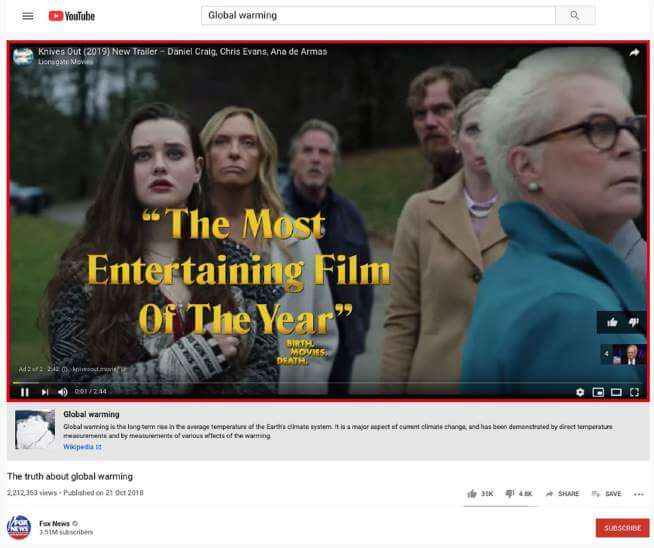
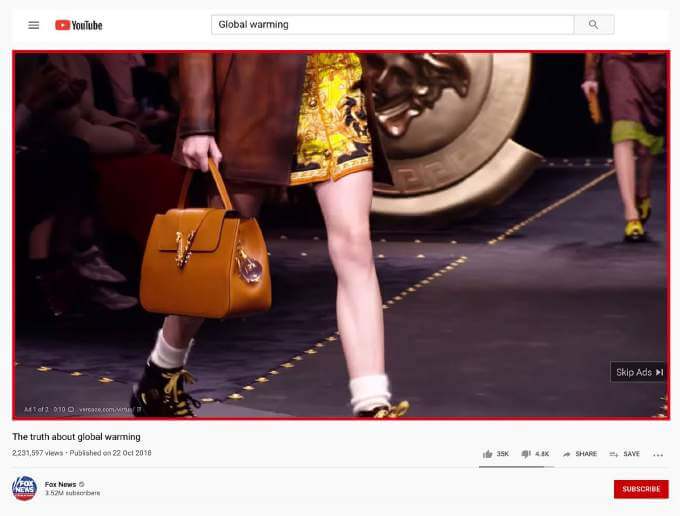
Versace Ad
Versace is an Italian luxury fashion label. The ad presents its new fall/winter handbag line “Virtus.” In 2018, Versace opened a sustainable design concept store in Bal Harbour. “There’s no bigger luxury than our future. The new Versace concept is a commitment towards Versace’s sustainable legacy,” Donatella Versace said in a statement.62
58The screenshot of the ad taken during this research has been altered for the sake of design. Copy of the originals are available upon request.
61The screenshot of the ad taken during this research has been altered for the sake of design. Copy of the originals are available upon request.
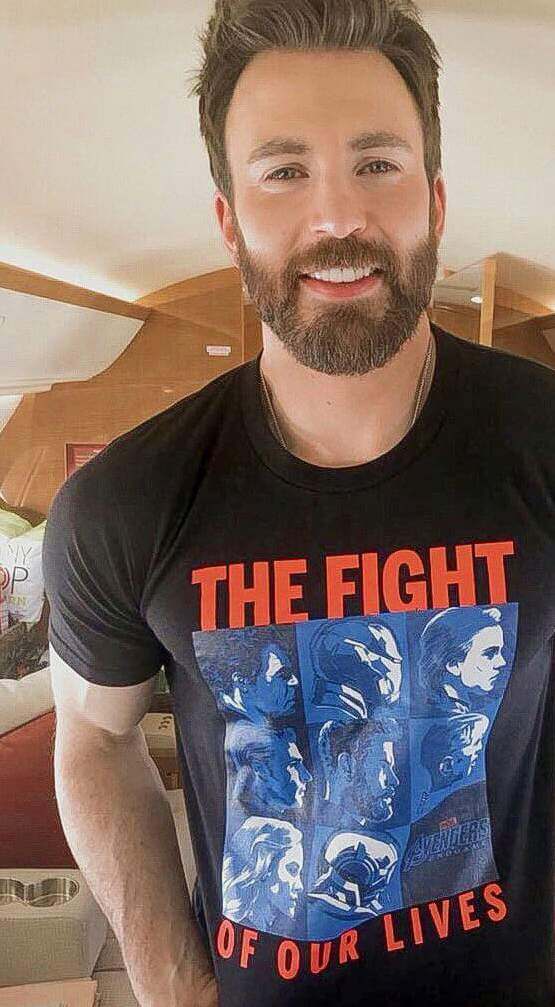
VIDEO EXAMPLE #3
Climate Change: What Do Scientists Say?63
Richard Lindzen who is narrating this video is a former professor at the Massachusetts Institute of Technology64and a former senior fellow at the Cato Institute65. At the time of Avaaz’s research66 in August, the video, posted on April 18th, 2016, had been viewed over 1.9 million times.
There are many claims in this video. Some of the main claims that Avaaz found to be misinformation include:
- “There is no evidence that CO2 emissions are the dominant factor [in climate change].” [1:48]
- The IPCC acknowledged in its own 2007 report that: “the long-term prediction of future climate states is not possible.”
- Only since the 1960s have man’s greenhouse emissions been sufficient to play a role in raising global mean temperatures.
On the first point, the scientific consensus is that CO2 is the main driver of climate change. This is borne out in the literature using direct measurement, historical data, and models.67
On the second point, Lindzen has cherry picked a quote from the IPCC’s 2001 report68 and incorrectly attributed it to the 2007 report. Read in context, the original 2001 quote is far from Lindzen’s meaning, and in the 2007 report the IPCC confirms that: “There is considerable confidence that climate models provide credible quantitative estimates of future climate change, particularly at continental scales and above.” 69
On the third point, this report already addressed a similar claim made by Patrick Michaels (see Video #2). In addition, the fifth IPCC report of 2014 stated: “It is extremely likely [95 percent confidence] more than half of the observed increase in global average surface temperature from 1951 to 2010 was caused by the anthropogenic increase in greenhouse gas concentrations and other anthropogenic forcings together.” 70

66August 2019
67IPCC 2013: The physical science basis. Working Group I contribution to the IPCC Fifth Assessment Report. Cambridge, United Kingdom: Cambridge University Press. www.ipcc.ch/report/ar5/wg1; NOAA 2016. The NOAA Annual Greenhouse Gas Index. Accessed June 2016. www.esrl.noaa.gov/gmd/aggi; Stips, A., Macias, D., Coughlan, C. et al. On the causal structure between CO2 and global temperature. Sci Rep 6, 21691 (2016); Royer, D.L., Berner, R.A., et al. CO2 as a primary driver of Phanerozoic climate: GSA Today, v. 14, no. 3, (2004)
Avaaz found eighteen brands advertising alongside this video over the course of our research. Below are examples of ads from Greenpeace and EToro.71
Greenpeace Ad
Greenpeace is a global non-governmental environmental organization. In this ad, Greenpeace Spain is campaigning to raise awareness of the threats posed by climate change to the country, saying: “Spain is one of the countries most vulnerable to climate change,”73 and is asking the public to sign a petition to be presented to the Spanish government to increase investment in green and clean energy sources.
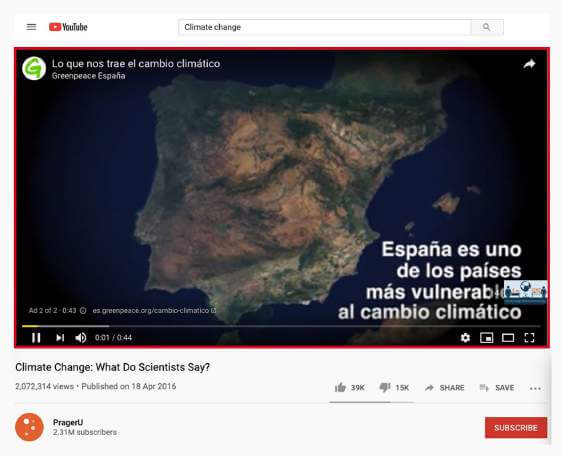
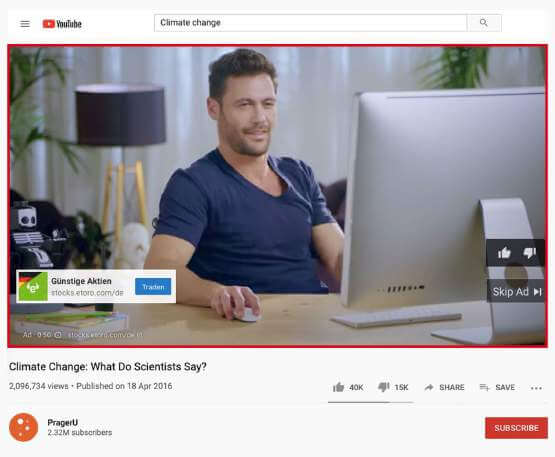
69Working Group I Contribution to the IPCC 4th Assessment Report, see p.600, FAQ 8.1 -https://www.ipcc.ch/site/assets/uploads/2018/05/ar4_wg1_ full_report-1.pdf
70IPCC 5th Assessment Synthesis Report. https://ar5-syr.ipcc.ch/topic_ observedchanges.php
71In the timeframe of Avaaz’ research between September 18th and September 24th
72The screenshot of the ad taken during this research has been altered for the sake of design. Copy of the originals are available upon request.
73Avaaz translation
74The screenshot of the ad taken during this research has been altered for the sake of design. Copy of the originals are available upon request.
76https://www.etoro.com/copyportfolios/renewableenergy (not possible to archive, request was blocked by the security rules by eToro)
VIDEO EXAMPLE #4
The Great Global Warming Swindle77
Funded by thirty brands including Samsung, Showtime Network and Atol
Released in 2007, “The Great Global Warming Swindle,” is a controversial film questioning the existence of a scientific consensus on global warming and the credibility of the IPCC. The video opens up with several different speakers all claiming that CO2 is not responsible for global warming. At the time of Avaaz’s research, the video had been viewed 873,934 times on YouTube since it was first posted there on August 19, 2018. Since then, it has racked up an additional 100,000 views.78
Most of the core claims in this video were debunked immediately after it was aired by George Monbiot for The Guardian.79 One of the video’s primary points, which Avaaz found to be misinformation, is that the current increase in global temperatures is caused by changes in the activity of the sun not by rising greenhouse gases. Much of the content in the video is built around the writing of Danish atmospheric physicist Dr. Eigil Friis-Christensen whose reports on this matter have been disproved, including by a well known peer-reviewed article published by Stanford University.80
The IPCC report from 2007,81 which was released one month before this video, stated that: “Human-induced warming of the climate system is widespread. (...) Greenhouse gas forcing has very likely caused most of the observed global warming over the last 50 years." 82 The summary for policymakers of that same report also stated: “Global atmospheric concentrations of carbon dioxide, methane and nitrous oxide have increased markedly as a result of human activities since 1750 and now far exceed pre-industrial values determined from ice cores spanning many thousands of years.”83
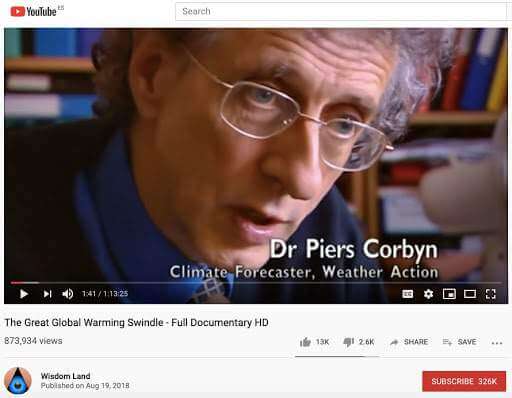
Thirty brands were found with ads running on this video, Samsung, Showtime Network and Atol.84
Samsung Ad
Samsung is a South Korean multinational electronics company, a major manufacturer of electronic goods. This ad is part of Samsung’s #SamsungBelief #DoWhatYouCant campaign. This particular ad tells the history of the company, describing how Samsung found its purpose: “Do the right thing for the people and eventually mankind.”86 Samsung says it is “committed to becoming a socially and environmentally responsible corporate citizen in all of its communities worldwide.”87
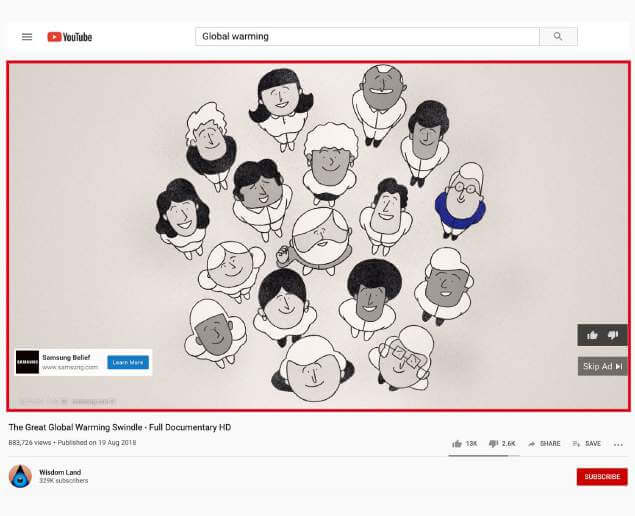
78As of December 12, 2019
80Laut, Peter. (2003). Solar activity and terrestrial climate: An analysis of some purported correlations. Journal of Atmospheric and Solar-Terrestrial Physics. 65. 801-812. Report can be found at: stephenschneider.stanford.edu/Publications/PDF_Papers/Laut2003.pdf
81Working Group I Contribution to the IPCC 4th Assessment Report https://www.ipcc.ch/site/assets/uploads/2018/05/ar4_wg1_full_report-1.pdf
84In the timeframe of Avaaz’s research between September 18 and September 24
85The screenshot of the ad taken during this research has been altered for the sake of design. Copy of the originals are available upon request.
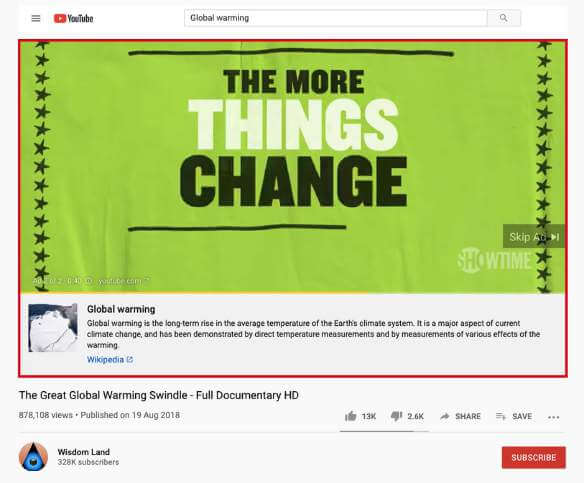
Showtime Ad
Showtime is a subscription television network from the U.S. that serves as the flagship service of the Showtime Networks subsidiary of CBS Corporation. This ad promotes the new season of one of its TV-series, “Shameless.” In 2014, Showtime produced “Years of Living Dangerously,” a documentary series on climate change. On its website89, CBS Corporation states: “Operating our businesses with sustainability in mind has long been a core value at CBS.”
ATOL Ad
ATOL is a large French optician chain that provides services across France. The ad promotes the company’s many stores. On the company website,91 ATOL states that it “deploys numerous devices to limit its ecological impact,” and that the company chooses to produce its products in France rather than in China to reduce its CO2 emissions.92
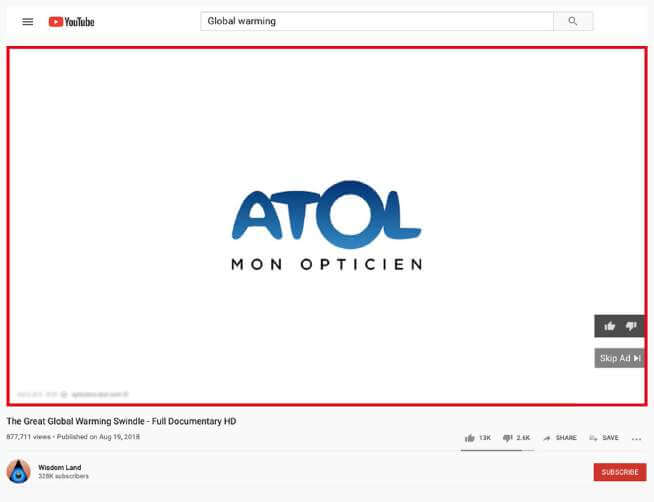
Recommendations
for YouTube to Act
Immediately
YouTube is defining the information space
for hundreds of millions of people every
day, and malicious actors are being allowed
to abuse the platform’s reach to achieve
harmful ends.

YouTube has a heightened responsibility to deal with disinformation and misinformation given the platform’s skyrocketing growth metrics. Its 1.9 billion registered users account for approximately 44% of the global population that uses the internet. One billion hours of videos are watched on YouTube every day.93 Eightyfive percent of US teenagers say they use the platform,94 and tween (9-12 year olds) and teen watch times have doubled in the last five years making YouTube their preferred social media platform.95
We do not question the fact that YouTube’s integrity and misinformation teams have taken strong and commendable steps in the direction of downgrading misinformation content. However, given the findings of our investigation -- compounded by the lack of solid data provided by YouTube to demonstrate its progress - - we believe the company’s actions thus far fall short of what is needed to defend our society against misinformation and disinformation.
Avaaz has consulted extensively with academics, lawmakers, civil society and social media executives to develop simple, rights-based and effective solutions to the misinformation and disinformation problem on YouTube and other social media platforms.
The most urgent policies that YouTube must implement are:
1. Detox YouTube’s Algorithms
The company must end its free promotion of misinformation and disinformation videos by extracting such videos from its recommendation algorithms, starting immediately by including climate misinformation in its borderline content policy.
2. Demonetize Misinformation &
Disinformation
Add misinformation and disinformation to YouTube’s relevant monetization policies, ensuring such content does not include advertising and is not financially incentivized. YouTube should start immediately with the option for advertisers to exclude their ads from videos with climate misinformation.
3. Correct the Record
Work with independent fact-checkers to inform users who have seen or interacted with verifiably false or misleading information, and issue corrections alongside these videos.
4. Transparency
Although YouTube promises to work openly with researchers, the company maintains an opaque process around its recommendation algorithms and on how effective its policies are in dealing with misinformation. YouTube should immediately release data showing the amount of views on misinformation content that were driven by its recommendation algorithms. YouTube must also work with researchers to ensure access to its recommendation algorithms to study misinformation.
These solutions are well within YouTube’s technical capabilities. By adopting these recommendations YouTube will stop its algorithm from promoting poisonous misinformation content and provide a warning to those who may have consumed it.
Detox YouTube’s
Recommendation
Algorithm
As this study shows, YouTube itself is actively recommending misinformation content to millions of users who wouldn’t have been exposed to it otherwise. To stop the spread of such dangerous content, YouTube must detoxify its algorithm by:
A. Extracting every video that has been identified as misinformation from its recommendation engine.
This means that YouTube must ensure that lies and misleading content are not freely promoted to users across the world. This policy is in line with what YouTube says96it’s already doing:
“We set out to prevent our systems from serving up content that could misinform users in a harmful way, particularly in domains that rely on veracity, such as science, medicine, news, or historical events [...] Ensuring these recommendation systems less frequently provide fringe or low-quality disinformation content is a top priority for the company.”
As this report shows, YouTube is not effectively living up to its own commitment. YouTube must immediately up its game to ensure that it does not promote misinformation, but sidelines it.
YouTube has a detailed system97 for rating content, which includes tools for identifying harmful misinformation. The platform also makes it clear that videos that “misinform or deceive users” -- especially about “content that contradicts well-established expert consensus” -- must be rated as the poorest quality content on the platform.98 This system makes it clear that the platform is both interested in and able to identify misinformation. However, rating content is not enough if it’s still going to be promoted widely.
To ensure that YouTube is no longer amplifying dangerous content, the platform should extract all videos known to be misinformation from its algorithms, starting immediately with climate denial and climate misinformation videos.
B. Three strikes rule for misinformation channels
YouTube already terminates channels if they accrue three Community Guidelines Strikes99 within 90 days. However, for spreading disinformation content, which Google’s Disinformation Whitepaper100 defines as “purposefully disseminating information one knows to be inaccurate with the hope that others believe it is true or to create discord in society,” channels are not penalized as that is not seen as a violation of the platform’s Guidelines.101 Avaaz believes YouTube should change its policy on this front, and hold channels that spread misinformation and disinformation accountable to an optimised version of its existing three strikes rule.
This would mean that if a channel is detected to have spread misinformation or to have violated YouTube’s guidelines in an effort to spread misinformation, deceive users or manipulate the YouTube algorithm (fake views, spam comments... etc) more than three times, all the channels’ content should be extracted from the algorithms. The channels should not be deleted, but neither should they be further accelerated.
Channels should of course be given an opportunity to issue corrections to their viewers or challenge the decision if they disagree with it, but those channels unwilling to stop their malicious behavior should not be amplified.
97https://kstatic.googleusercontent.com/files/388aa7d18189665e5f5579aef18e181c2d4283fb7b0d4691689dfd1bf92f7ac2ea6816e09c02eb98d5501b8e5705ead65af653cdf94071c47361821e362da55b
98YouTube and Google share the same content rating guidelines, which refer to “pages” rather than “videos.”https://support.google.com/youtube/answer/9230586 (“YouTube also uses third party evaluators to provide feedback on YouTube’s search results, recommendations, and the relevance of certain videos. This feedback helps us evaluate, train, and improve our systems, as well as the quality of recommendations on YouTube. These evaluators are trained using the same public guidelines that Google uses for search results.”).
101We were not able to find any mention in any of YouTube's policies of penalties for disinformation like those set out for violations of Community Guidelines.
Freedom of speech doesn’t mean freedom of reach. More details on how to implement the three strikes rule can be found in the Annex.
By implementing the three strikes rule for misinformation, YouTube would disincentivize malicious actors -- particularly given that 70% of the time users spend on the platform is driven by YouTube’s recommendations.102 A three strikes rule tackles misinformation while preserving freedom of expression -- videos aren’t deleted, but neither are disinformation videos or malicious actors boosted. With time, this policy will help ensure that high quality content is more prominently promoted by the algorithm, while misinformation actors and their videos are marginalised.
YouTube can begin by applying this policy to climate misinformation, but the platform needs to implement this solution on disinformation content across the board as soon as possible. A piecemeal approach will continuously give misinformation and disinformation actors the upper hand, particularly when these actors often change the topics they spread misinformation about.
C. Demonetize misinformation actors
YouTube’s Disinformation Policy103 clearly states that “monetization is a privilege.” Creators who meet the eligibility criteria104 (e.g. only channels with more than 30,000 subscribers) can apply to join the YouTube Partner Program, which makes their videos eligible to run and earn money through advertising.
As of now, monetizing creators must comply with advertiser-friendly content guidelines105,otherwise advertising will be disabled on these videos. Unfortunately, in reviewing YouTube’s relevant monetization policies, Avaaz was not able to find a direct mention of misinformation as a criteria for content where advertising is banned or disabled. The same was true for climate-specific misinformation and climate denial.
In order to disincentive creators from spreading false content to generate revenue, YouTube should add misinformation and political influence operations to its “Advertiser-friendly content guidelines”106 and demonetize content and channels spreading misinformation. Additionally, YouTube should start immediately with the option for advertisers to exclude their ads from videos with climate misinformation.
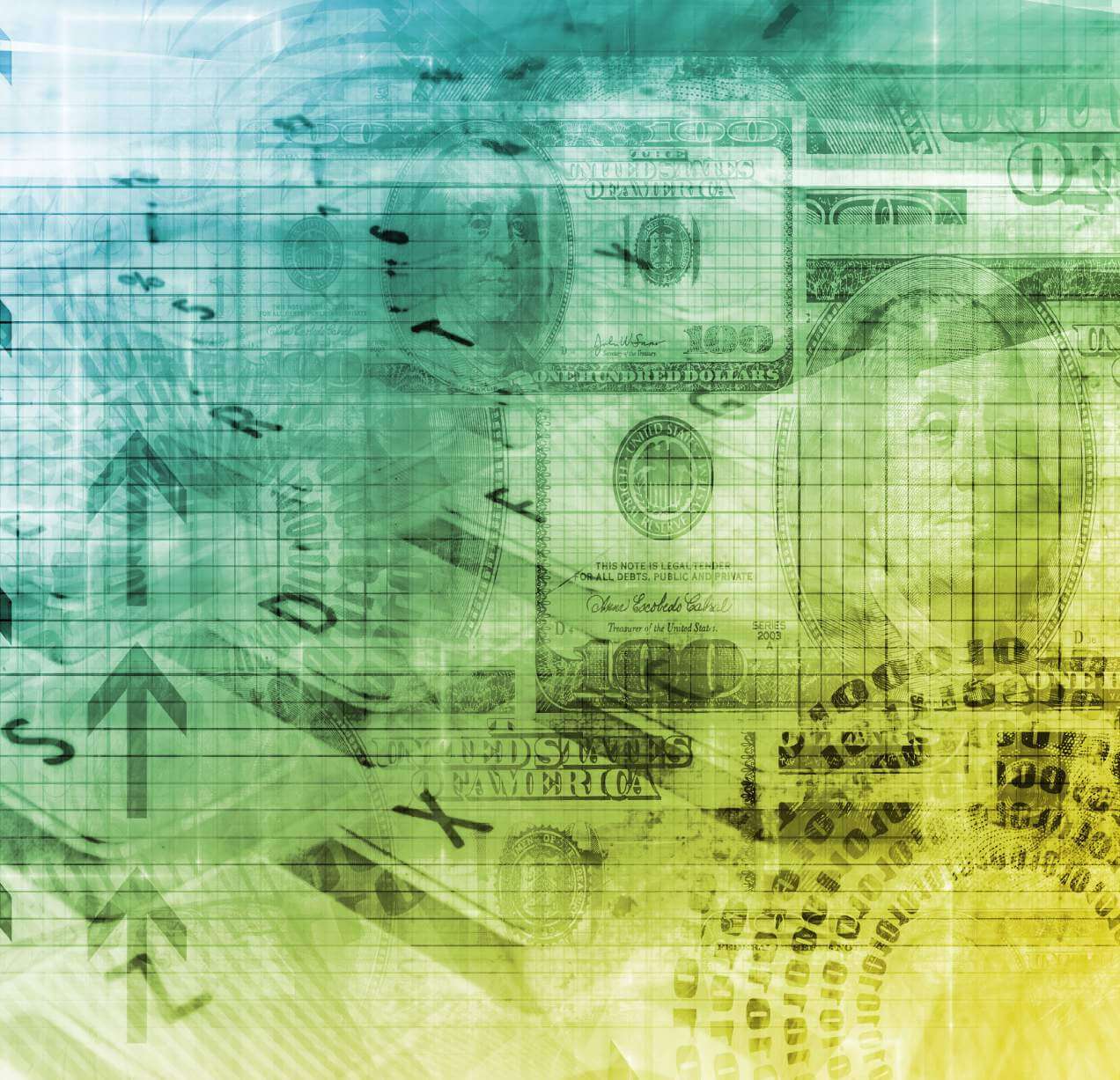
Correct the Record
Although detoxing the algorithm will significantly limit the spread of harmful content, the scale of the problem means that some viewers will inevitably be exposed to misinformation. That is why prevention alone is not enough -- we need a way to counteract the effects of disinformation after people have seen it.
YouTube must “Correct the Record” by providing corrections to each and every user who has seen content that independent fact-checkers determine to be verifiably false or misleading. This solution counteracts misinformation while preserving freedom of expression.
There is no censorship -- Correct the Record adds the truth but leaves the lies alone.
For YouTube, this would mean working with its content raters and using internal detection mechanisms such as AI tools and user feedback to detect misinformation videos and channels, sharing the flagged content with independent fact-checkers and, when a video is confirmed to be misinformation, adding a clear disclaimer before the video begins -- with a link to the factchecking website. It also means getting back to every user who ever saw the video and providing them with the relevant correction from the factcheckers.
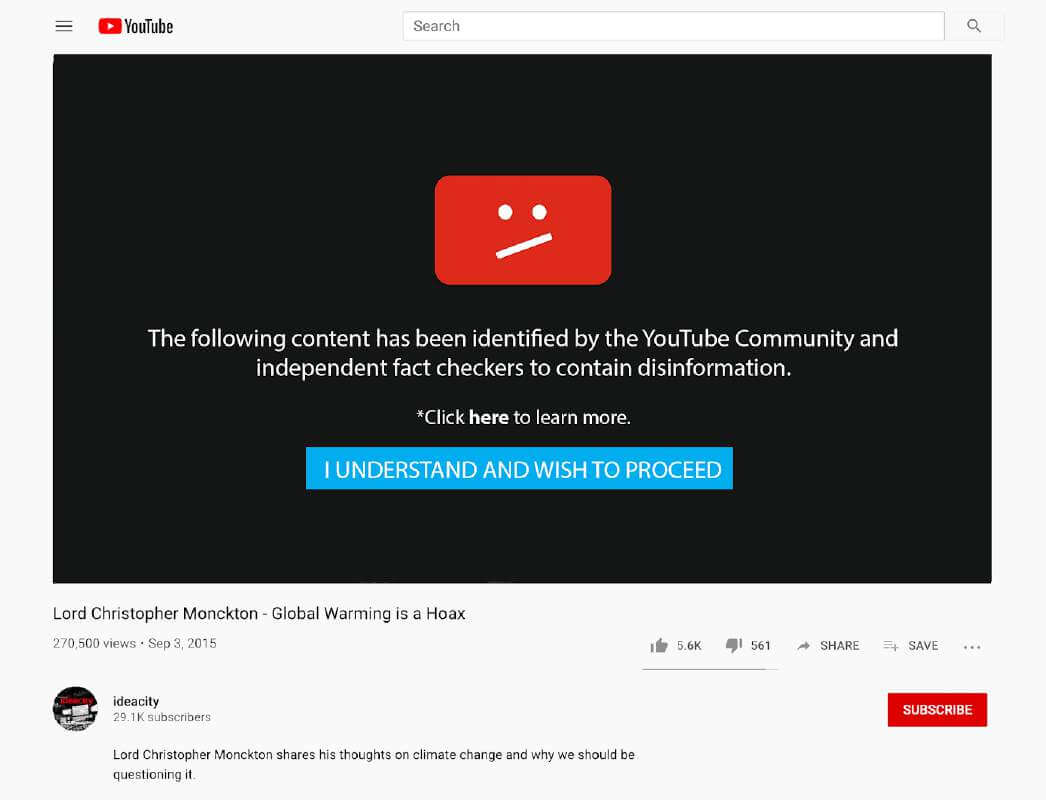
Recommendations
for Companies
In this day and age, consumers require
companies to be trustworthy and that trust
can be harmed by advertising alongside
misinformation content, especially when
those ads finance the creators and
promoters of that content.

As revealed in the 2017107 and 2018108 Cone Communications Corporate Social Responsibility Studies, more than three-quarters of Americans believe it is no longer acceptable for companies to just make money, they expect companies to positively impact society as well. Eightyseven percent of people surveyed said they would purchase a product because a company advocated for an issue they cared about and 76% would refuse to purchase a company’s products or services if they learned it supported an issue contrary to their beliefs.
Advertisers have a powerful role to play in collaborating with and pressuring YouTube to protect their brands and the well-being of society. And there is a growing trend of advertisers taking such actions. For example, companies have pulled109 their ads from YouTube after realizing that they were being shown on videos where inappropriate comments were being made about children. This led to expedited policy110 and enforcement111 changes at YouTube.
The Global Alliance for Responsible Media, representing the world’s biggest advertising firms, has highlighted that it is: “working towards a media environment where hate speech, bullying and disinformation is challenged, where personal data is protected, and used responsibly when given, and where everyone, especially children, are better protected from harm.”112
Avaaz calls on the members of the Global Alliance for Responsible Media and the brands identified in this report to use their advertising budgets as leverage to demand that YouTube stops displaying their ads on videos that promote climate misinformation, as well as to demand the platform takes proactive, systemic steps to ensure monetized videos are free of misinformation, starting immediately with climate misinformation.
Together, civil society, advertisers, and social media platforms can create a healthy information environment where freedom of expression is respected, communities are not manipulated by faulty algorithms and misinformation, and fair access to information is guaranteed. Given the challenges facing our democracies, our planet, and our economies, it is vital that we act now.
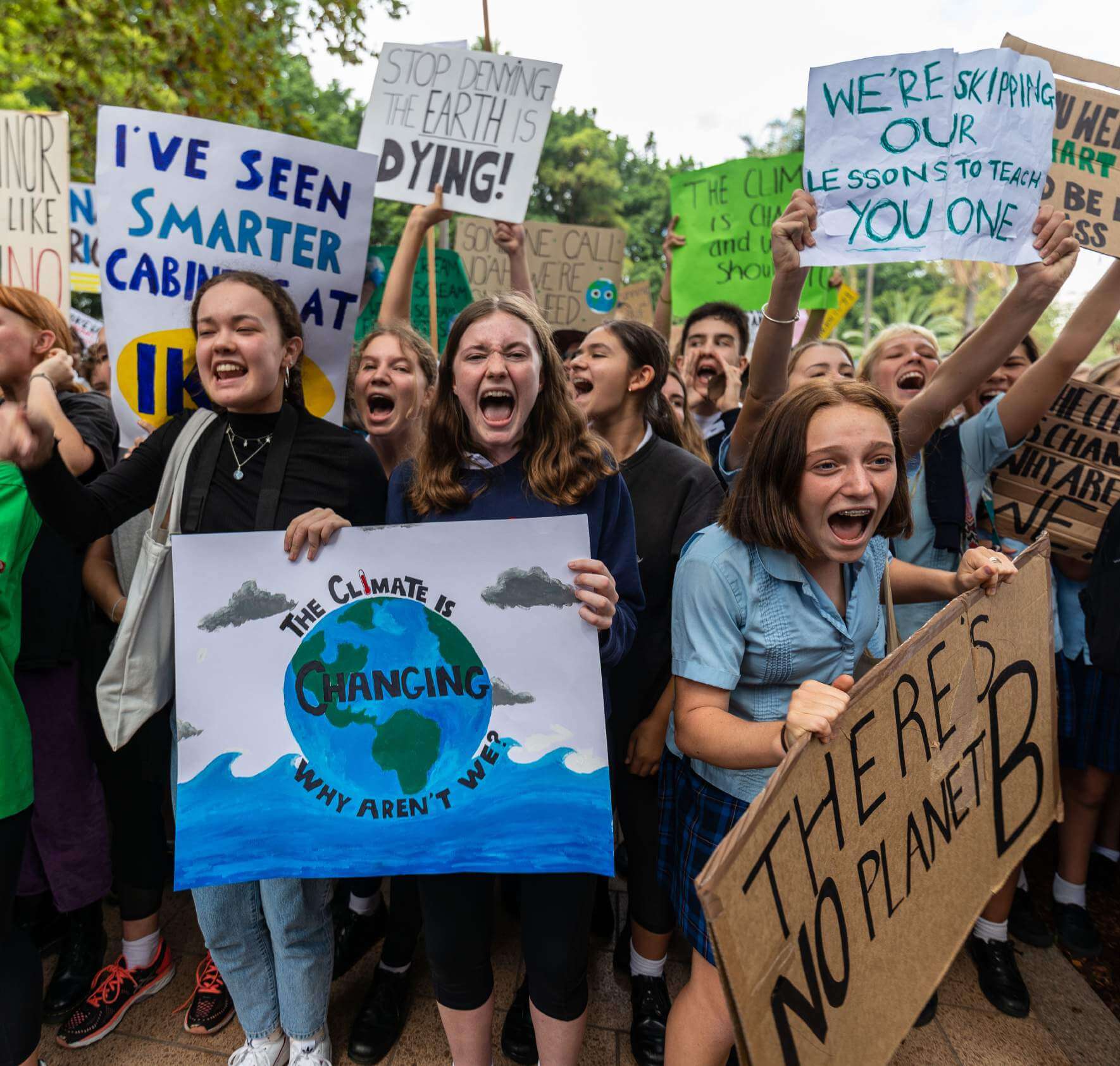
ANNEX
ANNEX 1:
Methodology for Part I:
How YouTube Promotes Climate Misinformation
Avaaz set out to investigate whether YouTube’s algorithms are boosting climate change denial and misinformation. Specifically, we were focused on which climate-related videos wind up on the right hand side of the watch page under ‘Up Next’, below the video on the mobile app, on the right of the screen on desktop. We chose the two neutral search terms “global warming” and “climate change” to analyse what type of videos would be recommended to an average YouTube user interested in the issue, as well as “climate manipulation” as a more charged search term, which refers to the conspiracy theory that powerful corporations and governments are controlling the climate.
Our first step (between August 5 and August 7, 2019) was to run each search term through YouTube Data Tools (YTDT). This tool uses access provided by YouTube to its own service. It takes a search term and generates a list of all the videos that are related to the top video results from the search term. Though YTDT does not provide an exact replica of YouTube’s suggestions algorithm, the YouTube API we used for our analysis is the one utilized by various researchers seeking to understand how the algorithm works, including Peer Reviewed Publications.113 For our three search terms, YTDT returned a list of 5,537 videos.
Multiple filters are used to inform what videos are included in YouTube’s ‘Up Next’ and suggestion bar. However, it is our understanding that related videos are very likely to make up the largest portion of the top videos recommended by YouTube as the YouTube algorithm heavily weighs how related a video is to the one being watched when it decides what to suggest to users -- especially for new users.114
We subsequently analyzed these results using Gephi,115 an open source visual data analysis tool for graph and network analysis, which allows you to easily compute the amount of times each video was recommended based on the database returned by YTDT. For each of the three search terms, we identified a list of the 100 most-recommended videos. The Avaaz team then screened those videos a first time to assess whether they might include climate denial/ misinformation.
Step three consisted of a more comprehensive watching those videos to verify whether they would be classified as “climate denial and misinformation”. We defined “climate denial and misinformation” as verifiably false or misleading information assessed against the scientific consensus represented by the Intergovernmental Panel on Climate Change, NASA, NOAA and peer-reviewed scientific literature, which has the potential to cause public harm, such as undermining public support for efforts to limit human-induced climate change. The content included ranges from denying that significant climate change is occuring, to claiming that human activity is not significantly responsible for it or denying that humans can take significant actions to reduce or mitigate its impact.
Our team identified potential false claims in the videos and then fact checked these claims using sources or research dated before the publication of the video. We used peer-reviewed scientific journals, reputable news organizations, and national or international institutions as fact checking sources. The videos were subsequently classified as “climate denial and misinformation videos.”
As a fourth step, we looked at who's behind the video and if the video as a whole fits with our classification of "climate denial and misinformation". We looked, for example, if the video is being disseminated by a known source of climate change misinformation, if the speaker is a known climate denier with a record of publishing incorrect statements despite numerous rebuttals available, or if the video shows a pattern of misleading or inaccurate claims.
As a fifth step, Avaaz researchers manually searched116the terms “global warming”, “climate change”, and “climate manipulation” on YouTube in incognito mode in multiple countries. Our team then followed the recommended videos for these search terms, and several of the misinformation videos our study flagged from the YTDT dataset appeared in the “Up Next” panel and suggestions bar, confirming that Youtube’s algorithms were still promoting them as of December 2019.117
In the course of designing our methodology, Avaaz consulted with key experts and data scientists. The only other paths we found available to have a better analysis of the climate-related videos recommended by YouTube’s algorithms were:
- Manually scanning through YouTube videos (which would take 10 employees 708 full working days each);
- YouTube providing us with access to its algorithm (which the company is unwilling to do); or
- Violate YouTube’s terms of service.
YouTube has challenged other investigations of this nature -- often by suggesting that the backend of the platform shows different information than independent researchers can openly see -- but rarely does the platform provide tangible evidence for those statements. Avaaz welcomes YouTube to share any concrete data that can shed a more holistic light on the path misinformation travels on its platform.
114Joonseok Lee, Nisarg Kothari, Paul Natsev. Content-based Related Video Recommendations, Advances in Neural Information Processing Systems (NIPS) Demonstration Track, 2016.http://www.joonseok.net/papers/video_recs_demo.pdf
116In December 2019
117Screenshots available
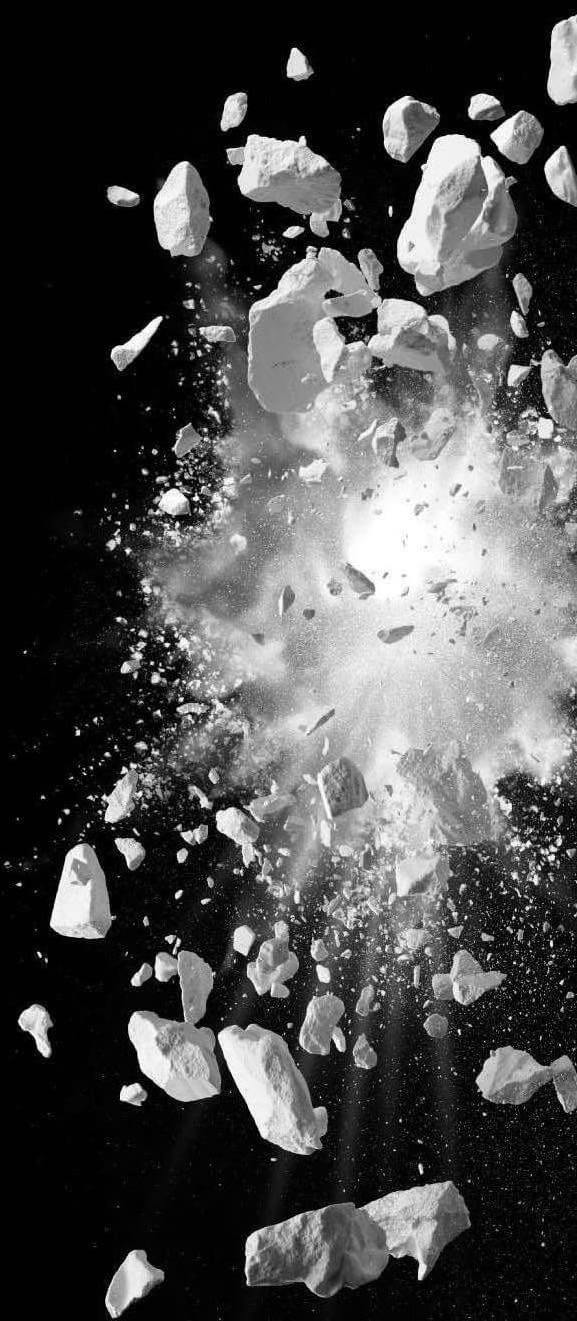

ANNEX 2:
Methodology for Part II:
Climate Misinformation Videos on YouTube & the Global Brands Advertising on Them
Between September 18 and September 24, Avaaz set out to investigate which ads from which brands or campaigns were appearing on the climate change misinformation videos we identified.
We reviewed which ads were being shown on the top 10 recommended videos for the search term “global warming” and the top 5 most viewed videos for each of the other two search terms. To do this, the Avaaz team used a VPN connection for a specific country (in order to have a representative sample in key global countries, we selected Spain, the US, the UK, Germany, France, and Brazil), and used the Google Chrome browser in incognito mode to look for the videos based on their title or identification code.118Each search was run five consecutive times, every time in a new incognito window.
118 All YouTube videos have a unique identification code.
ANNEX 3: Table -
Climate Misinformation Videos Analyzed for Part II
| Search term: Global Warming | Channel | Views |
|---|---|---|
| What They Haven't Told You about Climate Change | PragerU, 2.31M subscribers | 2,695,102 |
| The truth about global warming | Fox News, 3.5M subscribers | 2,000,427 |
| Climate Change: What Do Scientists Say? | PragerU, 2.31M subscribers | 1,982,846 |
| Nobel Laureate Smashes the Global Warming | 1000frolly PhD, 31.3K subscribers | 1,738,290 |
| ACTUAL SCIENTIST: Climate Change is a Scam! | StevenCrowder, 4.13M subscribers | 1,371,327 |
| The Great Global Warming Swindle - Full Documentary HD | Wisdom Land, 328K subscribers | 859,213 |
| WHY I SAID GLOBAL WARMING IS THE BIGGEST FRAUD IN HISTORY - Dan Pena | London Rea | London Real, 1.07M subscribers | 694,352 |
| Fatal Flaw In Climate Change Science | Suspicious0bservers, 426K subscribers | 266,921 |
| Lord Christopher Monckton - Global Warming is a Hoax | Ideacity, 27.8K subscribers | 258,563 |
| 25 NASA Scientists Question the Sanity of the Global Warmists | 1000frolly PhD, 31.3K subscribers | 255,348 |
| Search term: Climate manipulation | Channel | Views |
| What They Haven't Told You about Climate Change | PragerU, 2.31M subscribers | 2,695,102 |
| The truth about global warming | Fox News, 3.5M subscribers | 2,000,427 |
| Climate Change: What Do Scientists Say? | PragerU, 2.31M subscribers | 1,982,846 |
| Nobel Laureate Smashes the Global Warming Hoax | 1000frolly PhD, 31.3K subscribers | 1,738,290 |
| CIA Whistleblower Speaks Out About Climate Engineering Vaccination Dangers and 911 | Dane Wigington, 101K subscribers | 11,688,452 |
| Search term: Climate Change | Channel | Views |
| The truth about global warming | Fox News, 3.5M subscribers | 2,000,215 |
| Climate Change: What Do Scientists Say? | PragerU, 2.31M subscribers | 1,982,811 |
| Nobel Laureate Smashes the Global Warming Hoax | 1000frolly PhD, 31.3K subscribers | 1,738,280 |
| The Great Global Warming Swindle - Full Documentary HD | Wisdom Land, 328K subscribers | 859,213 |
| Fatal Flaw In Climate Change Science | Suspicious0bservers, 426K subscribers | 266,914 |
ANNEX 4:
Full List of Brands Found by Avaaz on Climate Misinformation Videos
What They Haven’t Told You about Climate Change
4Ocean, 4Patriots, Aeromexico, Danone, Decathlon, Ecosia, eToro, Eureciclo, Greenpeace, NIKIN, Universidade Presbiteriana Mackenzie
Climate Change: What Do Scientists Say?
4Patriots, Aeromexico, eToro, 4Ocean, Eureciclo, FinalStraw, Font Vella, Greenpeace, NIKIN, Ottonova, Decathlon, DonaldJTrump.com, Harley Davidson, Maserati, SeLoger, Wenigermiete, Youzu Interactive, Zipcar
The Great Global Warming Swindle - Full Documentary HD
Action Coach, Aricanduva, Cadre Emploi, City of Kawasaki, Code Institute, EPISOD Sports Studio, ATOL Opticians, Café Intención, Ecosia, Eureciclo, Font Vella, Freedom Mentor, Grammarly, Ivory Ella, NIKIN, Aeromexico, Honey, DonaldJTrump.com, Samsung, Showtime network, Sketchers, Versace, Learn to Trade, MyHeritage, Pi Investimentos, Superdry, VUDU, Wenigermiete, Youzu Interactive, Zipcar
The Truth About Global Warming
Arnal Real Estate, Aeromexico, Code Institute, Danone, Decathlon, DonaldJTrump.com, L'Oreal, Lionsgate, Versace, Ecco, 4Ocean, eToro, DrSmile, Eureciclo, Font Vella, German government, Ottonova, Sebrae, Kichler, Learn to Trade, Masterclass, Mon Coach de Golf, Norton 360, Petra Picks, Pi Investimentos, Rehau, SeLoger, Simplifieurs, The Neck Hammock, Weekly Money Multiplier, Youzu Interactive
WHY I SAID GLOBAL WARMING IS THE BIGGEST FRAUD IN HISTORY - Dan Pena | London Real
Acquisitions, Avec elisa, Cadre Emploi, City of Kawasaki, Code Institute, dgachieve.com, Digital Dream Lifestyle, eToro, Golf TV, 4Ocean, DrSmile, Ecosia, Honey, Eureciclo, Interactive Advisors, Font Vella, Aeromexico, Danone, Decathlon, Hyundai, L'Oreal, Learn to Trade, Malui Center, MyHeritage, Hanwha, Instituto Brasileiro de Florestas, NIKIN, Stelara, Pi Investimentos, Superdry, Terra chips, Youzu Interactive, Zipcar
Lord Christopher Monckton - Global Warming is a Hoax
Action Coach, Blue Sky Amazon, Cadre Emploi, City of Kawasaki, Code Institute, eToro, Expert Market, Golf TV, Groupon, JasonLMV.com, Jeff Anderson & Associates, 7-eleven, Learn to Trade, Cathay Pacific, Decathlon, Ethiad Airways, MyHeritage, 4Ocean, American Diabetes Association, Ecosia, Eureciclo, Font Vella, Instituto Brasileiro de Florestas, Ivory Ella, NIKIN, Norrøna Sport, Noom, Pi Investimentos, Harley Davidson, Reserva, SOS children’s villages, World Wildlife Fund, Greenpeace, Stitch Fix, Superdry, Hertz, L'Oreal, Tradenet, Red Bull, Uber, Under Armour, Upwork, Versace, Aeromexico, Bike Itau, Wenigermiete, Westfield, White House Black Market, Youzu Interactive
CIA Whistleblower Speaks Out About Climate Engineering Vaccination Dangers and 911
Fisher Wallace, Hear Clear, Instituto Brasileiro de Florestas, Aeromexico, Carrefour, DonaldJTrump. com, L'Oreal, Nintendo Switch, Telhanorte, Noom, Banque des Territoires, Uber, Blue Sky Amazon, Warner Bros, Code Institute, Ottonova, Save the Children, eToro, Expert Market, Freedom Mentor, Fresh Direct, JasonLMV.com, Learn to Trade, My College Laptop, MyHeritage, Natural Health Reports (.net), Norrøna Sport, Passion Into Profit, Pi Investimentos, Superdry, VUDU, Wenigermiete, Westfield, WPengine, Youzu Interactive
ANNEX 5:
Further Examples of Advertisements Running on Climate Misinformation Videos
Example #1
Avaaz found 35 brands had ads running on the video, CIA Whistleblower Speaks Out About Climate Engineering, Vaccination Dangers and 911,119 including Carrefour, Telhanorte and Uber.120
Carrefour's Ad
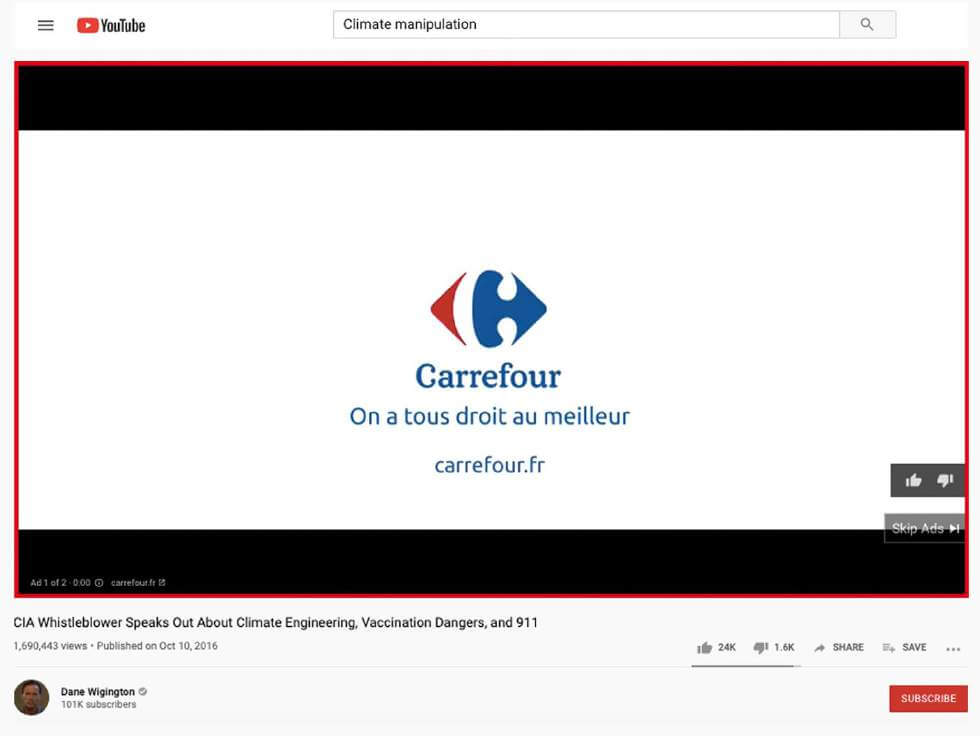
Telhanorte’s Ad
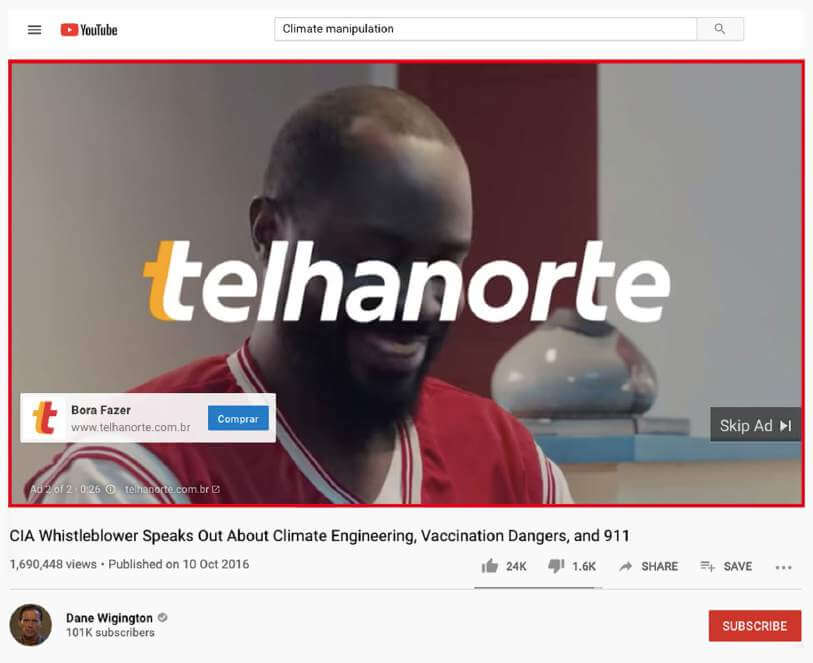
Uber’s Ad
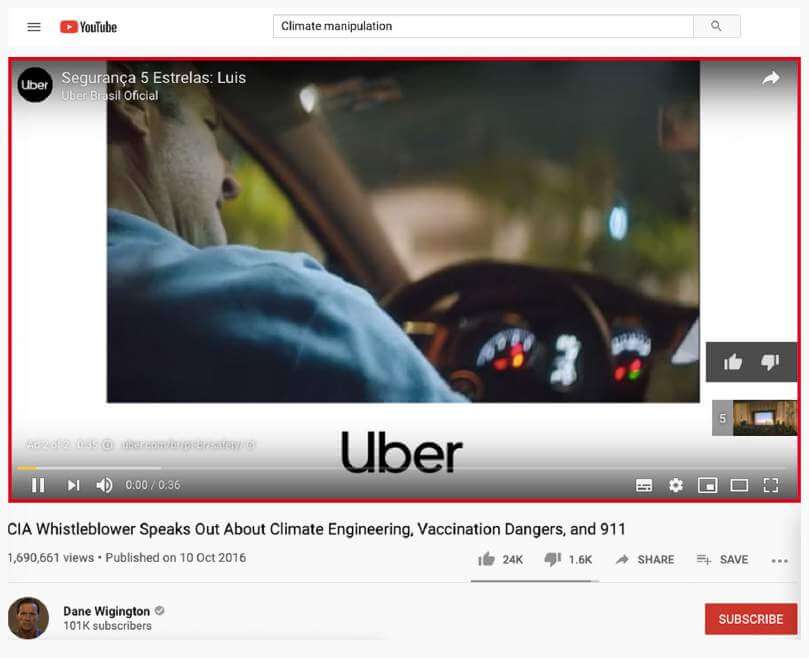
120In the timeframe of Avaaz’s research between September 18 and September 24
Example #2
Avaaz found 49 brands had ads running on the video, Lord Christopher Monckton - Global Warming is a Hoax,121 including WWF, 7Eleven, Bike Itaú, and Cathay Pacific.122
World Wildlife Fund (WWF)’s Ad
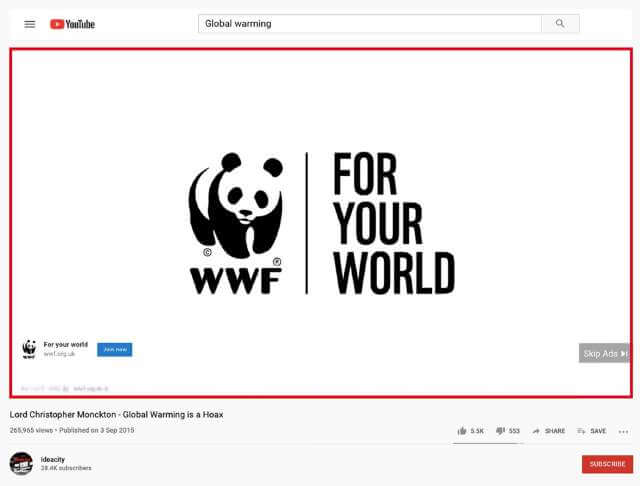
Bike Itaú’s Ad
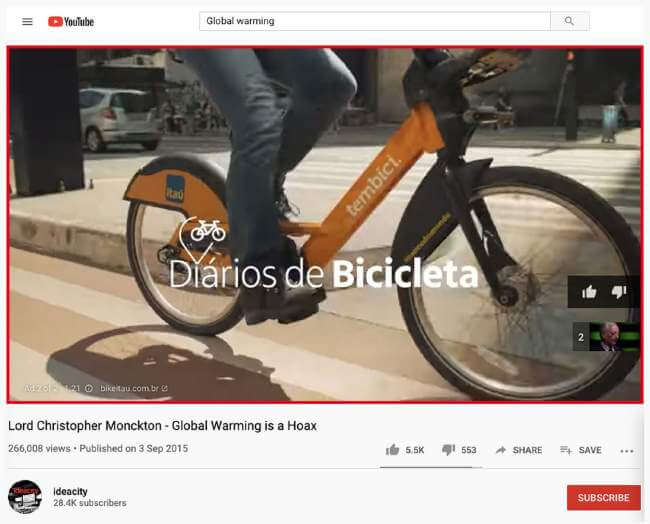
7-Eleven’s Ad

Cathay Pacific’s Ad
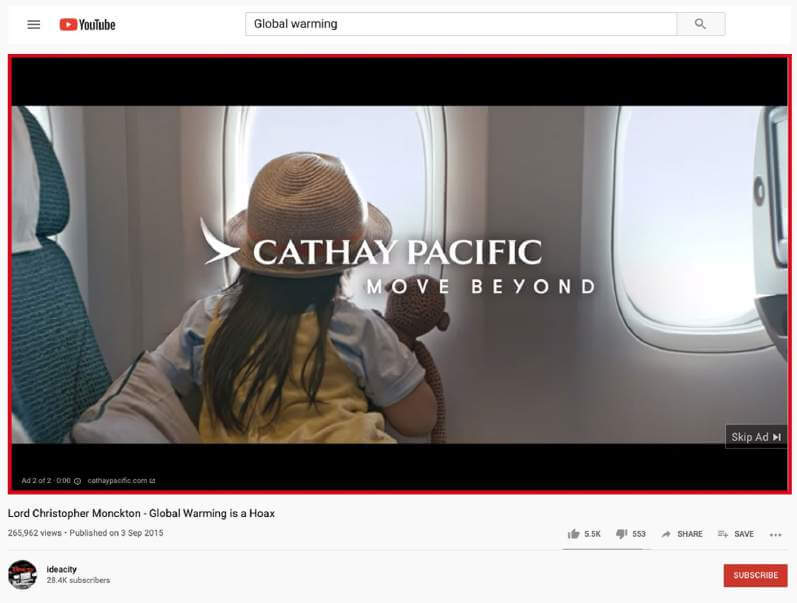
122 In the timeframe of Avaaz’s research between September 18 and September 24
Example #3
Avaaz found 33 brands had ads running on the video, WHY I SAID GLOBAL WARMING IS THE BIGGEST FRAUD IN HISTORY - Dan Pena | London Real, 123 including City of Kawasaki and Instituto Brasileiro de Florestas.124
City of Kawasaki’s Ad
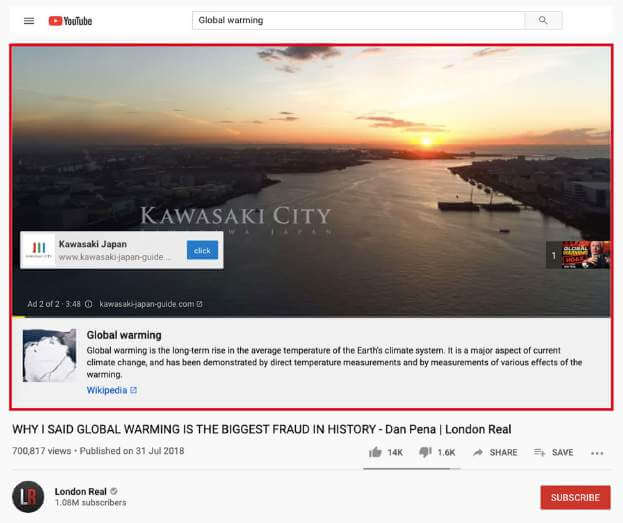
Instituto Brasileiro de Florestas’s Ad
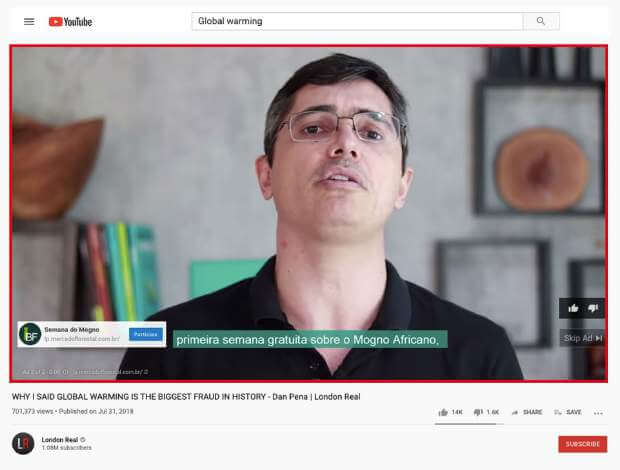
124 In the timeframe of Avaaz’s research between September 18 and September 24

Geen opmerkingen:
Een reactie posten
Opmerking: Alleen leden van deze blog kunnen een reactie posten.